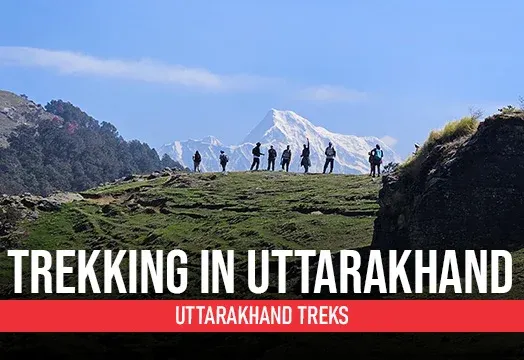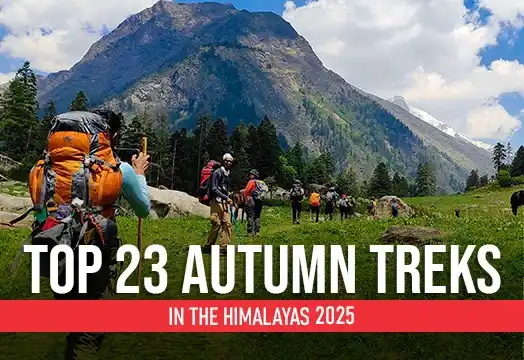Panchkedar Trek & Drive

Region
Uttarakhand | India

Duration
12 Days

Max Altitude
12000 Ft.

Trekking Km
107 KM

Grade
Moderate to Difficult
Get in Touch with Our Trek Expert
91 9917724737 info@trekthehimalayas.comMonday - Saturday: 10 AM to 06 PM (GMT +5:30)
54500 /Person
- September-2025
- October-2025
- 5% GST will be applicable on Trek Cost and Add-ons
- Services Rishikesh to Rishikesh | Included Transport.
- Meeting Point( Pickup/ Drop Point ): Opposite Shiv Vilas Hotel, Tapovan, Rishikesh
- Reporting Time: 6:00 am
- Drop Time: 6:30 pm to 7:30 pm (Timings are subject to change based on weather and road conditions).
- Please reach Rishikesh a day before to avoid any delays.
Get in Touch with Our Trek Expert
91 9917724737info@trekthehimalayas.com
Monday - Saturday: 10 AM to 06 PM (GMT +5:30)
Overview
Trek Name: Panchkedar Trek & Drive
Days: 12
Adventure Type: Pilgrimage Tours
Base Camp: -
Season:Summer | Monsoon |
Month:May | June | September | October |
Country: India
Altitude: 12000 Ft.
Grade: Moderate to Difficult
Rail Head: Haridwar/Rishikesh is the nearest rail head to the base camp
Stay: Hotel/Guesthouse/Village Homestay and Camps (Triple/Quad sharing)
Food: Meals while on trek & at Hotel/Guesthouse (Veg & Eggs)
Location: Uttarakhand
Distance: 107 Km.
Trail Type: -
AirPort: Jolly Grant Airport, which is 21 km away from Rishikesh
Highlights:
- 5% GST will be applicable on Trek Cost and Add-ons
- Services Rishikesh to Rishikesh | Included Transport.
- Meeting Point( Pickup/ Drop Point ): Opposite Shiv Vilas Hotel, Tapovan, Rishikesh
- Reporting Time: 6:00 am
- Drop Time: 6:30 pm to 7:30 pm (Timings are subject to change based on weather and road conditions).
- Please reach Rishikesh a day before to avoid any delays.

Why is Panch Kedar a Must-Do Trek?
- The Panch Kedar Yatra takes you through five holy temples, nestled among the beautiful Himalayas. These five sacred shrines include Kedarnath, Tungnath, Rudranath, Madhyamaheshwar and Kalpeshwar.
- Each site holds unique mythological importance, offering a spiritual journey alongside the physical adventure with beautiful views.
- All these five shrines are dedicated to Shiva and the Trek to Panch Kedar is intertwined with tales from the Mahabharata, and believed to be built by the Pandavas.
- Tungnath is often regarded as the highest temple among the Panch Kedar, but in terms of altitude, Kedarnath, situated at 11,700 feet, is actually the highest. However, the Tungnath trek takes you further to the Chandrashila peak, the highest point in the region. From there, you can enjoy mesmerizing panoramic views of Nanda Devi, Trishul, Chaukhamba, and many more.
- Chandrashila and other high-altitude points along the trek provide some of the most spectacular sunrise and sunset views over the Himalayan ranges.
- The trek takes you through dense forests and alpine meadows to cascading waterfalls and snowy peaks, during the trek you get wide panoramic views of the Garhwal Himalayas.
.webp)
Who Can Participate
- Age Requirement:
- Minimum 14 years
- First-timers are welcome, though prior trekking experience is preferred. Good fitness is a must.
- Fitness Criteria:
- If the trekker wants to carry a backpack then he/she should be able to carry a 10-12 kg backpack. If opt Off-load option then the trekker should be able to carry 3-5 kg backpack.
- If a trekker's BMI is more or less than the normal range (18-27), please consult our Trek Coordinator before booking.
Panchkedar Trek & Drive Itinerary
Drive from Rishikesh to Pipalkoti
- Altitude (Pipalkoti): 1,340 m / 4,400 ft
- Drive Distance: 215 km | 8-9 hours
- Accommodation: Guest House
Your Panch Kedar adventure begins with a long yet beautiful drive from Rishikesh to the Pipalkoti town, located in the Garhwal Himalayas. The journey sets the tone for the days to come, providing a stunning introduction to the region’s majestic landscapes and spiritual aura.
The drive starts early in the morning, with Rishikesh’s lively streets slowly giving way to the winding mountain roads. The terrain will gradually shift from the bustling plains to the cooler heights of the Himalayas, where every curve shows breathtaking views. As you begin your ascent, you’ll be treated to panoramic vistas of verdant valleys, and hills.
Along the way, you’ll witness the remarkable confluence of rivers at Devprayag, where the Bhagirathi and Alaknanda merge to form the sacred Ganga. This spot is revered for its spiritual significance and captivating beauty.
The drive continues through Rudraprayag and Karnaprayag, two more stunning river confluences, and appreciate the natural splendor of the region. These stops also provide a glimpse into the local culture, with bustling roadside markets, small temples, and traditional Himalayan homes.
For lunch or snacks, roadside dhabas offer an authentic experience with a variety of local treats like aloo paratha and dal chawal, giving you a taste of the traditional flavors of the mountains. The drive is a delightful mix of natural beauty, cultural immersion, and culinary indulgence.
As you ascend further, the weather becomes cooler, and the atmosphere grows more tranquil. By evening, you’ll reach Pipalkoti, a town surrounded by lush hills. After checking into your guesthouse, you’ll have the chance to unwind and acclimatize to the altitude. The calm setting provides a perfect respite after the long journey, and you can enjoy a warm meal while gazing at the starlit Himalayan sky. The peaceful atmosphere of Pipalkoti marks the beginning of your trek, setting a serene and reflective mood for the adventure ahead.
Drive from Pipalkoti to Kalpeshwar and Back to Pipalkoti
- Altitude:
- Pipalkoti: 1,340 m / 4,400 ft
- Kalpeshwar: 2,100 m / 6,900 ft
- Drive Distance: 70 km (round trip) | 4 hours
- Accommodation: Guest House
After a peaceful night in Pipalkoti, you'll begin your day early, ready for a short yet deeply rewarding journey to Kalpeshwar, one of the Panch Kedar temples. This day promises a blend of spiritual tranquility, and cultural immersion, as you drive through the mesmerizing landscapes of the Garhwal Himalayas.
The road to Kalpeshwar is a delightful journey, with every turn revealing the charm of the mountains. The route takes you through winding mountain roads bordered by small welcoming villages. Vibrant bursts of wildflowers in the surrounding meadows add a burst of color to the landscape, while the mountain air provides a refreshing contrast to the warmth of the morning sun. As you move further, you’ll feel the environment change, with the elevation and air growing thinner, rejuvenating both body and mind with every breath.
Kalpeshwar, perched at an altitude of 6,900 ft, holds a special place among the Panch Kedar temples. It is believed to be the site where Lord Shiva’s locks (Jata) were worshipped by the Pandavas in their pursuit of penance, as chronicled in the Mahabharata. The temple’s serene and isolated setting adds to its mystique. The spiritual aura that envelops the place, combined with its stunning natural surroundings, offers an ideal setting for reflection and peace. Kalpeshwar stands out from the other temples in the Panch Kedar group, as it is accessible year-round, unlike the others which are often closed due to snow in the winter months.
Upon arrival at Kalpeshwar, a short walk from the parking area brings you closer to the temple, which is tucked away in a valley. The temple itself is simple yet captivating, with its architecture blending harmoniously into the natural landscape. The greenery surrounding the temple creates an awe-inspiring atmosphere. This is a place where the soul can truly connect with divinity, as you offer prayers and absorb the calmness that emanates from the surroundings.
Take your time exploring the temple and its sacred premises, soaking in the spiritual significance and the quietude that Kalpeshwar offers. The surrounding natural beauty, paired with the deep-rooted spirituality of the place, creates a truly unique and fulfilling encounter.
After spending some time immersed in the peaceful aura of Kalpeshwar, you’ll retrace your journey back to Pipalkoti. Upon your return to Pipalkoti, unwind at the guest house and reflect on the sacredness of the day’s journey. As you enjoy a hearty dinner, the peaceful surroundings of Pipalkoti allow for quiet contemplation of the spiritual experience. With your mind and spirit nourished, you can relax and prepare for the upcoming adventures that lie ahead on your Panch Kedar trek.
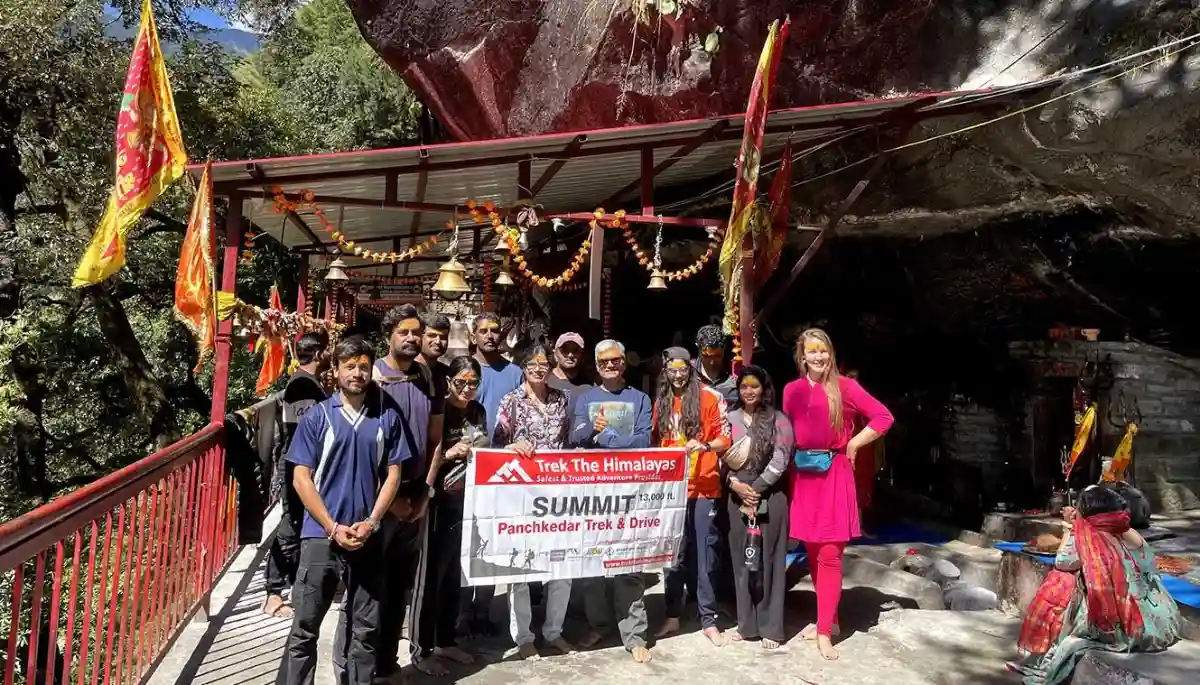
Drive from Pipalkoti to Sagar Village and Trek to Lyuti Bugyal
- Altitude:
- Pipalkoti: 1,340 m / 4,400 ft
- Sagar Village: 1,700 m / 5,600 ft
- Lyuti Bugyal: 3,000 m / 10,000 ft
- Drive Distance: 30 km | 1 hour
- Trek Distance: 8 km | 6-7 hrs
- Accommodation: Tent
Today, your day begins with a delightful one-hour drive from Pipalkoti to Sagar Village. The drive, though short, is scenic, showing glimpses of terraced fields, mountain ridges, and villages nestled in the foothills. Sagar Village, a serene and beautiful hamlet, serves as the starting point of today’s trek.
The trek to Lyuti Bugyal starts with a gradual ascent through dense forests of oak and rhododendron. As you progress, the serene ambiance is punctuated by the sound of chirping birds and the rustling of leaves. Small streams crisscross the path, adding to the charm of this forested stretch.
Midway through the trek, you’ll come across patches of grasslands that eventually lead to Lyuti Bugyal. The bugyal, perched at an altitude of 3,000 meters, is a sprawling alpine meadow surrounded by towering mountains. As you step into this tranquil haven, the pristine beauty of the landscape is bound to leave you spellbound.
Once at Lyuti Bugyal, you’ll set up camp amidst the undisturbed wilderness. The cool mountain air and breathtaking views provide the perfect setting to relax after the day’s trek. As evening falls, the meadow transforms into a stargazer’s paradise, with a blanket of stars lighting up the night sky.
Enjoy a warm meal prepared at the campsite as you soak in the tranquility of the surroundings, preparing for the adventures awaiting you the next day.
Trek from Lyuti Bugyal to Rudranath and Back
- Altitude:
- Lyuti Bugyal: 3,000 m / 10,000 ft
- Rudranath: 3,550 m / 11,600 ft
- Trek Distance: 18 km (both ways) | 10-12 hrs
- Accommodation: Tents
This day is a test of endurance and determination as you undertake the trek to Rudranath, one of the Panch Kedars and a sacred destination. The trail starts early from Lyuti Bugyal, meandering through dense alpine forests and ascending steeply in parts. Expect to walk through a mix of grassy slopes and rocky patches, with the occasional mountain stream crossing the path.
As you climb higher, the forest opens up to spectacular vistas of the Himalayan ranges, including peaks like Nanda Devi and Trishul. Along the way, you may encounter small shrines and prayer flags fluttering in the breeze, creating a feel of spirituality. The final stretch to Rudranath involves a steeper climb but rewards you with a breathtaking sight of the temple dedicated to Lord Shiva. The chirping of birds, rustling of leaves, snow-capped peaks and the serene meadows add to the serenity of the journey, and Rudranath exudes a divine aura.
As you ascend, the vegetation gradually gives way to high-altitude meadows, providing unobstructed views of the towering Himalayan ranges, including Nanda Devi, Trishul, and Chaukhamba. The final stretch to Rudranath is marked by rocky terrain, requiring careful navigation. Upon reaching Rudranath, you are greeted by the magnificent stone temple dedicated to Lord Shiva, surrounded by untouched natural beauty. Rudranath is where Lord Shiva's face is worshipped.
Spend some time here, offer prayers and soak in the spiritual ambiance. The temple is perched amidst pristine meadows, with breathtaking views of peaks. After paying homage, begin your descent to Lyuti Bugyal. The trek back, though easier downhill, is equally scenic, with golden light bathing the landscape as the day progresses. Once back at the campsite, relax under the starlit sky, reminiscing about the day's incredible journey.
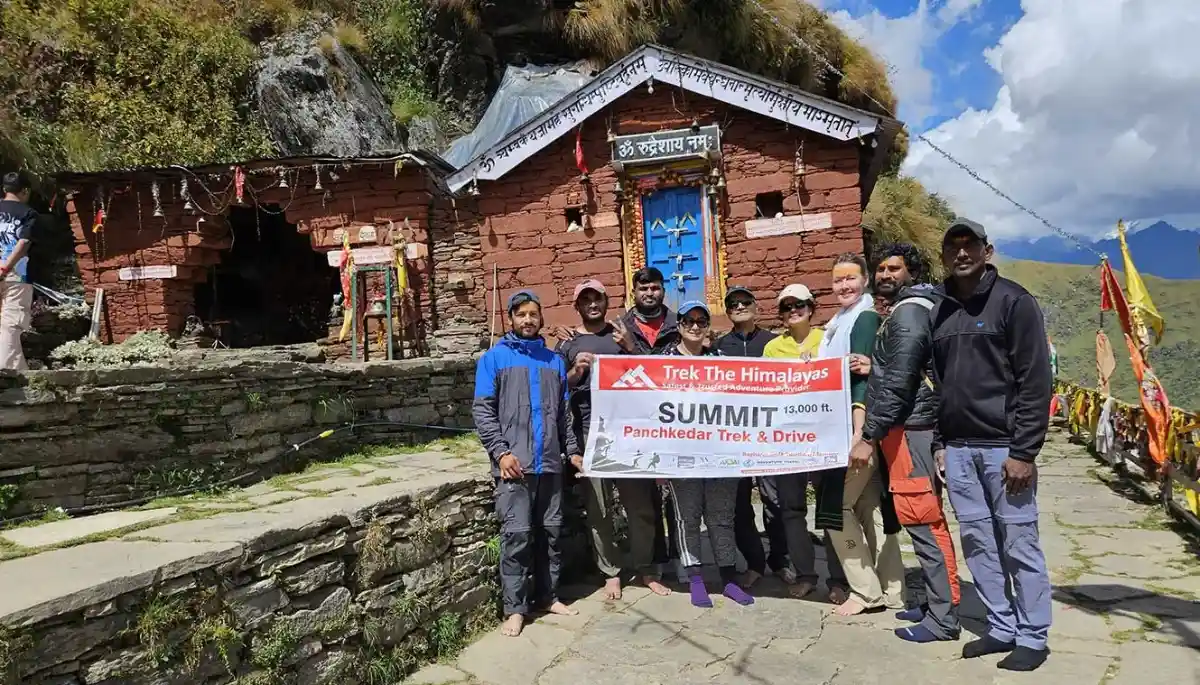
Trek from Lyuti Bugyal to Sagar Village and Drive to Chopta
- Altitude:
- Lyuti Bugyal: 3,000 m / 10,000 ft
- Sagar Village: 1,700 m / 5,600 ft
- Chopta: 2,900 m / 9,500 ft
- Trek Distance: 8 km | 4-5 hrs
- Drive Distance: 35 km | 1-2 hrs
- Accommodation: Guesthouse
The day begins with a descent from Lyuti Bugyal to Sagar Village. The trek downhill takes about 4-5 hours and is a relatively easier walk compared to previous days. The trail retraces your steps through the lush forests and rolling meadows, and provides yet another chance to immerse yourself in the natural beauty. You make your way downhill, and will pass through the same vibrant forests and rolling meadows that accompanied you earlier.
Once you arrive at Sagar Village, your trekking boots take a break as you switch to a vehicle for a drive to Chopta, often referred to as the "Mini Switzerland of India." The drive, lasting approximately three hours, is an experience in itself. The route meanders through charming villages, dense deodar forests, and valleys adorned with streams and waterfalls. Along the way, you’ll notice the changing landscape as you move towards higher altitudes.
Upon arrival in Chopta, you’ll be welcomed by the cool, invigorating mountain air and stunning views of the surrounding Himalayan peaks. The rolling meadows, dense forests, and panoramic views of majestic peaks like Kedarnath Main, and Chaukhamba create an enchanting atmosphere that soothes the soul and refreshes the mind.
The simplicity of life here, complemented by the untouched beauty of its surroundings, makes Chopta a paradise for nature lovers and trekkers. The hill station also serves as a haven for bird watchers, with sightings of exotic Himalayan birds like the Himalayan Monal, Khalij Pheasant, and even the rare Snow Partridge making it a delight for enthusiasts.
Take a moment to explore the meadows and nearby forests if time permits. The gentle rustling of leaves, the occasional call of a distant bird, and the whisper of the breeze through tall oak, pine, and rhododendron trees create a serene symphony. In spring, Chopta bursts into vibrant hues of red and pink, thanks to the blooming rhododendrons, while winters cloak it in a blanket of snow, transforming the landscape into a winter wonderland.
Settle into your accommodation, and enjoy the peaceful charm of this hill station. As the day winds down, prepare yourself for the next leg of your Panch Kedar journey to Tungnath and Chandrashila.
Trek from Chopta to Tungnath Temple and Back to Chopta (Optional Hike to Chandrashila)
- Altitude:
- Chopta: 2,900 m / 9,500 ft
- Tungnath Temple: 3,500 m / 11,500 ft
- Chandrashila Peak: 3,700 m / 12,000 ft (optional)
- Trek Distance: 8-9 km (both ways) | 7-8 hrs
- Accommodation: Guesthouse
The sixth day of the journey is an enchanting mix of spirituality, scenic beauty, and adventure. The trek begins early from Chopta, with its lush meadows and breathtaking views of the Himalayan ranges.
The trail to Tungnath Temple, the highest of the Panch Kedar shrines, is a well-paved and gradual ascent, making it accessible yet rewarding. The climb takes you through a landscape adorned by rhododendron trees, with vibrant red blossoms adding color to the greenery during spring. The air grows thinner as you climb, but the sweeping views of peaks like Kedarnath Main, and Chaukhamba motivate every step.
Upon reaching Tungnath Temple, situated at an altitude of 3,500 meters, you are greeted by the divine aura of the centuries-old shrine dedicated to Lord Shiva. Mythologically, it is believed to be the place where Lord Shiva’s arms appeared. This temple is connected to the Pandavas' journey for penance, as they searched for Lord Shiva to absolve themselves of their sins after the Mahabharata war. Spend time exploring the intricately carved stone architecture and soaking in the serene atmosphere. Offer your prayers and marvel at the panoramic Himalayan vistas that surround this sacred site.
For those seeking an additional adventure, the optional trek to Chandrashila Peak awaits. This 1 km stretch is steep and challenging but immensely rewarding. At 3,700 meters, Chandrashila shows a 360-degree view of the Himalayan ranges, including Trishul, Nanda Devi, and Chaukhamba and many more. The feeling of standing atop this peak is exhilarating, with the peaks glowing in the sunlight or covered in a mystical mist, depending on the time of day.
After soaking in the breathtaking views, descend back to Chopta. Back here, unwind and reflect on the day’s spiritual and adventurous experiences while resting in your guesthouse. This day’s trek is often considered the highlight of the Panch Kedar journey, blending divine blessings with awe-inspiring nature.
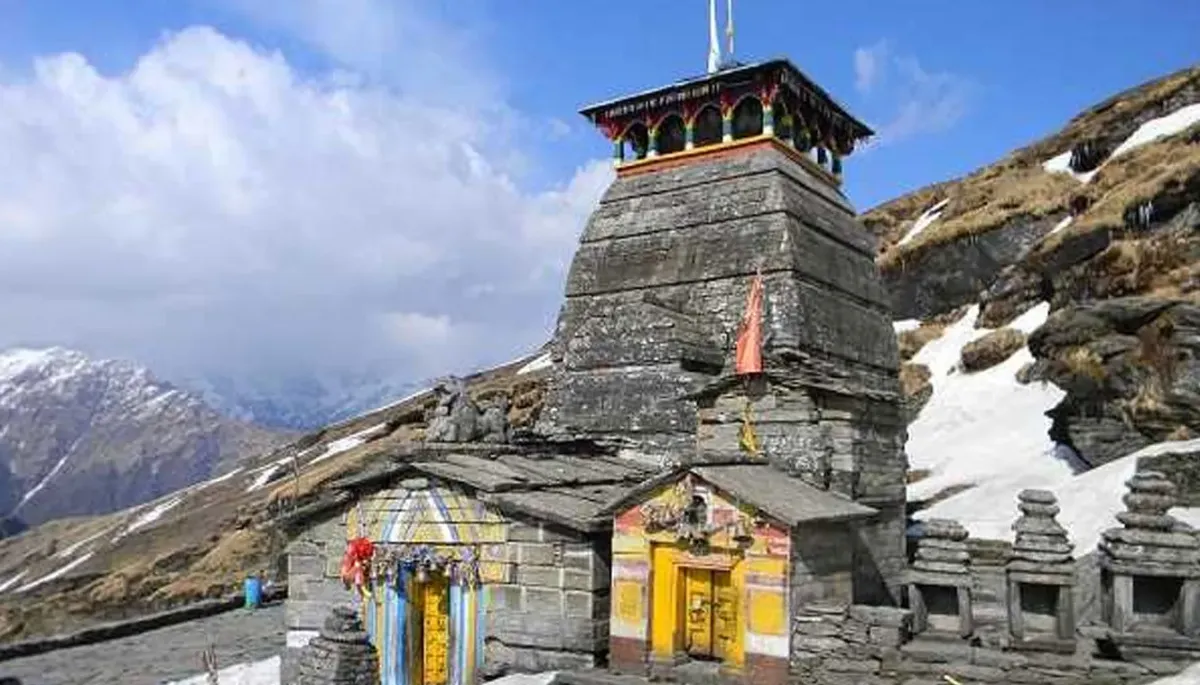
Drive from Chopta to Ransi and Trek to Gaundhar
- Altitude:
- Chopta: 2,900 m / 9,500 ft
- Ransi: 2,000 m / 6,500 ft
- Gaundhar: 1,800 m / 5,800 ft
- Drive Distance: 52 km | 3-4 hrs
- Trek Distance: 6 km | 4-5 hrs
- Accommodation: Homestay
After breakfast, your day begins with a drive from Chopta to Ransi village. The drive winds through the verdant valleys of Uttarakhand, with mesmerizing views of terraced fields, dense forests, and the occasional glimpse of snow-capped peaks in the distance. The road trip takes you through villages and you will also witness the Mandakini River, the charm of the journey.
Upon reaching Ransi, the starting point for the trek, you’ll prepare for a short hike to Gaundhar. Ransi, a small and serene village, acts as a gateway to the Madhmaheshwar trail and provides a glimpse of the traditional lifestyle of the locals. The trek from Ransi to Gaundhar is about 6 km and is a moderate descent through lush green forests, and sparkling mountain streams.
While walking, the sound of chirping birds and the gentle flow of water from nearby streams keep you company. The trail shows occasional clearings that provide stunning views of the surrounding hills and valleys. Along the way, you might spot locals engaged in farming or tending to their livestock, offering a glimpse into the simplicity of mountain life.
Gaundhar, situated at the river of the Madhyamaheshwar Ganga and serves as the perfect base for the next leg of the trek. The village is surrounded by thick forests and rolling meadows, providing a serene and peaceful atmosphere.
Upon reaching Gaundhar, settle into your homestay. Spend the evening relaxing, soaking in the natural beauty, and perhaps enjoying a warm meal under the starry sky. The day ends with a wonderful blend of drives, a comfortable trek, and a chance to connect with the tranquility of the mountains. It also sets the stage for the more challenging but rewarding treks ahead.
Trek from Gaundhar to Madhmaheshwar
- Altitude:
- Gaundhar: 1,800 m / 5,800 ft
- Madmaheshwar: 3,200 m / 10,600 ft
- Trek Distance: 10 km | 6-7 hrs
- Accommodation: Homestay or Community Hall
Your trek to Madhmaheshwar begins with an early breakfast at Gaundhar, where the beautiful surroundings and fresh mountain air help prepare you for the day ahead. As you start the trek, you’ll gradually gain altitude, ascending through dense forests that are home to a variety of flora and fauna. The trail initially takes you with the sound of gushing water accompanying your steps, and the path becomes steeper as you proceed.
The first few kilometers are characterized by a gradual climb, passing through thick oak and rhododendron forests. These forests are lush and provide shade as you move upwards, offering occasional views of the towering peaks in the distance. The trek is peaceful, with only the rustle of leaves and birds calling out as your companions.
As you ascend, you’ll encounter small meadows and clearings, where the views of the surrounding mountain ranges become more breathtaking. The trek becomes more challenging as the altitude increases, but the stunning scenery makes every step worth it.
Around halfway through, you’ll cross small streams and rivulets that require some careful navigation. The crisp mountain air becomes thinner, and the landscape changes as the tree cover starts thinning out, making way for alpine meadows. The climb can be quite strenuous, but your determination is rewarded with every new vista.
After about 6-7 hours of trekking, you will reach Madhmaheshwar, a sacred site famous for the Madhmaheshwar Temple. Here, Lord Shiva's navel is worshipped. The views around the temple, with snow-capped peaks surrounding the valley, are awe-inspiring. After reaching the temple, you’ll have time to relax and explore the surroundings before setting in Homestay or Community Hall.
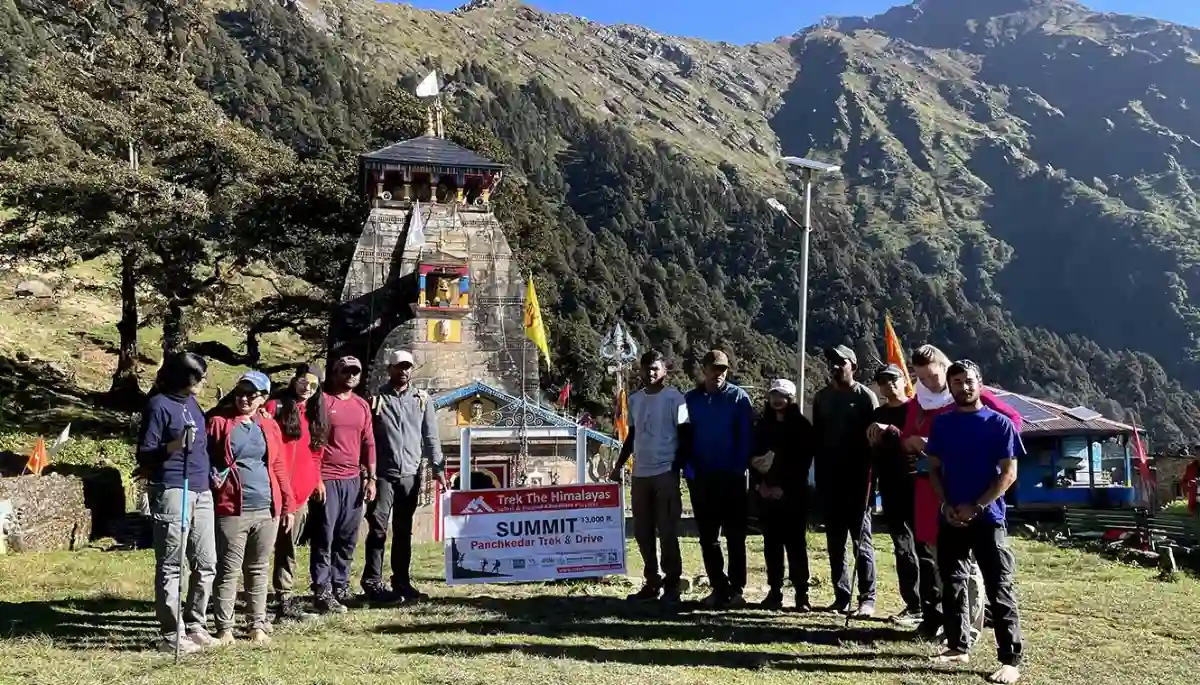
Trek from Madhmaheshwar to Ransi and Drive to Guptakashi/Phata
- Altitude:
- Madhmaheshwar: 3,200 m / 10,600 ft
- Ransi: 2,000 m / 6,500 ft
- Guptakashi: 1,400 m / 4,500 ft
- Trek Distance: 16 km | 8-9 hrs
- Drive Distance: 45 km | 2-3 hrs
- Accommodation: Guesthouse
Today’s trek marks the return journey from the sacred Madhmaheshwar back to Ransi. After breakfast, you will begin your descent from Madhmaheshwar, leaving the sacred temple and alpine surroundings behind. The trail descends gradually through alpine meadows and dense forests, providing glimpses of the mountain peaks that you passed earlier.
The first part of the trek will be mostly downhill, and you’ll descend into the forested valleys, with the rhythmic sound of rustling leaves and streams keeping you company. The terrain here can be a bit rocky and uneven, so be mindful of your footing as you navigate through the changing landscapes. The air becomes thicker as you lose altitude, and you’ll feel the temperature rising as you near Ransi.
As you approach Ransi, you’ll find yourself gradually transitioning into lower altitudes, where the terrain flattens and opens up into small rural villages and terraced fields. The sight of people going about their day-to-day lives in this beautiful mountain region will give you a sense of the local culture and lifestyle. You will reach Ransi after 8-9 hours of trekking.
Once you reach Ransi, you’ll take a well-deserved break and then proceed with a drive to Guptakashi, which will take around 2-3 hours. The drive will be through winding mountain roads, and as you descend further, you’ll notice the landscape changing once again, with lush greenery and valleys becoming more prominent.
Guptakashi, a town famous for its ancient temples, is your destination for the night. After checking into your guesthouse or hotel, you’ll have some time to relax and unwind after a long day of trekking and traveling. Take the opportunity to explore Guptakashi’s surroundings, and perhaps visit the Guptakashi Temple before settling in for the night, reflecting on your incredible journey through the Himalayan landscapes.
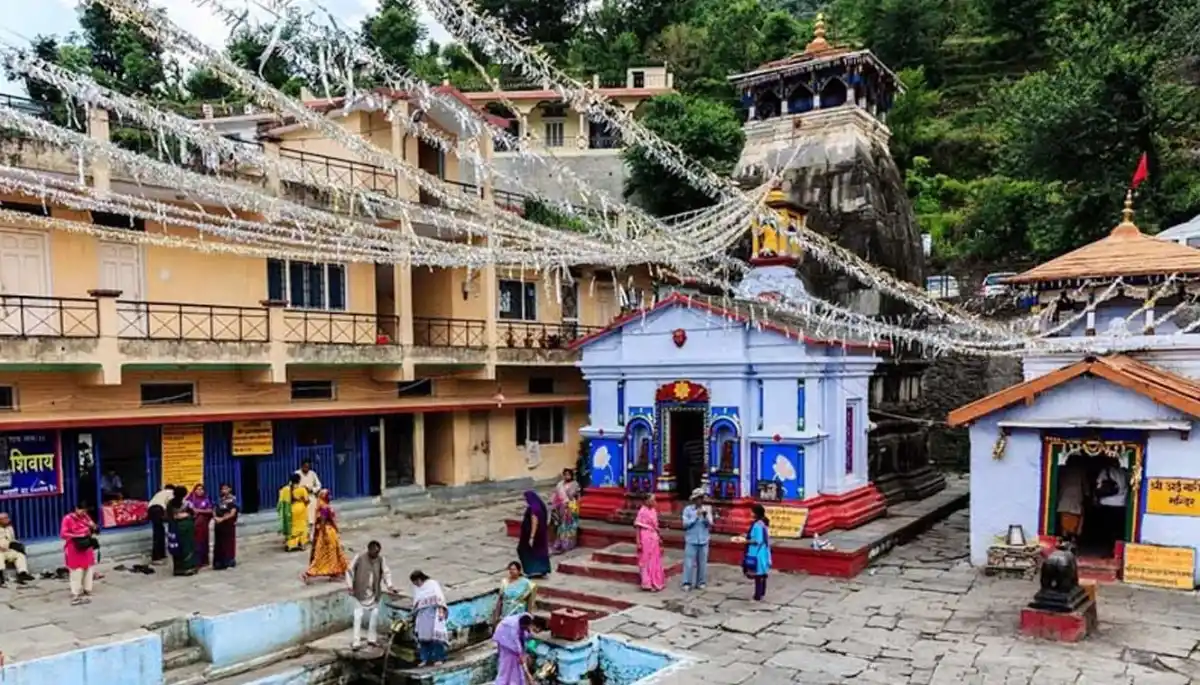
Drive from Guptakashi/Phata to Gaurikund and Trek to Kedarnathji
- Altitude:
- Guptakashi: 1,400 m / 4,500 ft
- Gaurikund: 2,000 m / 6,700 ft
- Kedarnath: 3,600 m / 11,700 ft
- Drive Distance (Guptakashi to Gaurikund): 35 km | 2-3 hrs
- Trek Distance: 16 km | 8-9 hrs
- Accommodation: Guesthouse at Kedarnath
Today marks a significant milestone in your Panch Kedar journey. You will start the day with a hearty breakfast at your accommodation in Guptakashi or Phata. From there, you will embark on a short drive to Sonprayag, a key transit point on the journey to Kedarnath. At Sonprayag, it is mandatory to switch to a local vehicle to cover the remaining 5km distance to Gaurikund, the base for the Kedarnath trek. This regulation helps manage the high influx of pilgrims and ensures safety on the narrow mountain roads. This journey, taking approximately 2-3 hours in total, takes you through the stunning views of the lush valleys and surroundings.
Upon reaching Gaurikund, the starting point for your trek to Kedarnath, you will feel the anticipation build. Gaurikund is a town with pilgrims and trekkers gearing up for the long trek to Kedarnath. From Gaurikund, the 16 km trek to Kedarnath begins. The path, which ascends steadily, takes you through varied landscapes, including pine forests, lush meadows, and rocky terrain.
As you trek upwards, you will pass by cascading waterfalls, clear mountain streams, and, at times, the rhythmic sound of bells from nearby temples. The trek is moderately strenuous, with occasional steep stretches, but the scenery along the way makes it a beautiful journey.
After around 8-9 hours of trekking, you will finally reach Kedarnath, a place that holds great religious and spiritual significance. The Kedarnath temple, one of the most revered temples in the Hindu religion, sits majestically against a backdrop of towering peaks Kedarnath, and the surrounding landscapes are simply awe-inspiring.
Once you reach the temple, take some time to offer your prayers and immerse yourself in the sacred atmosphere. The sound of bells and chants fills the air, enhancing the sanctity of the experience.
Kedarnath, dedicated to Lord Shiva and holds deep spiritual significance in Hindu mythology. According to legend, after the Kurukshetra war, the Pandavas sought Lord Shiva's blessings for redemption. However, Lord Shiva, unwilling to forgive them easily, took the form of a bull and hid in the Garhwal Himalayas. At Kedarnath, his hump emerged from the ground and became the site of the temple.
The temple draws pilgrims from across the globe, each seeking blessings and a sense of spiritual renewal. The surrounding silence, broken only by the chants and the tolling bells, deepens the divine experience, making it a moment of connection and reverence.
Afterward, you will settle in for the night at Kedarnath, where you can stay in a guesthouse. The chilly mountain air and the serene ambiance provide the perfect setting to rest after a challenging yet fulfilling day. Rest and reflect on the day's achievements, and get ready for the descent tomorrow.
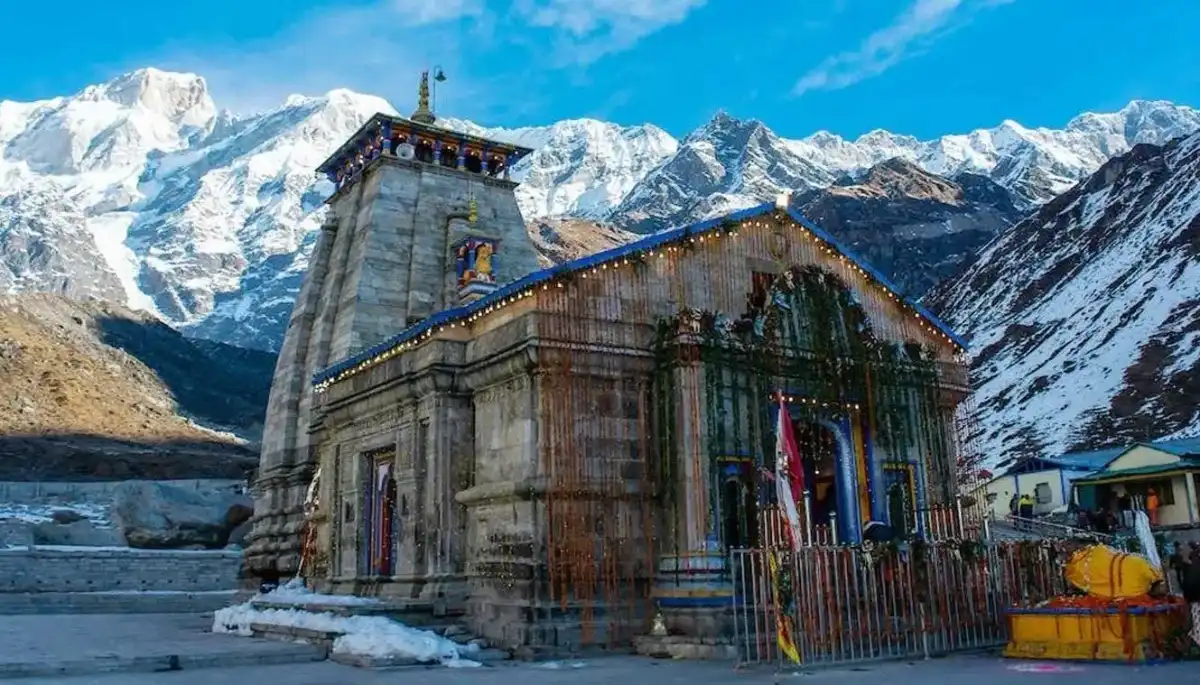
Descend from Kedarnath to Gaurikund and Drive Back to Guptakashi/Phata
- Altitude:
- Kedarnath: 3,600 m / 11,700 ft
- Gaurikund: 2,000 m / 6,700 ft
- Guptakashi: 1,400 m / 4,500 ft
- Drive Distance: 35 km | 2-3 hrs
- Trek Distance: 16 km | 8-9 hrs
- Accommodation: Guesthouse
After a spiritually enriching experience at Kedarnath, it’s time to begin your descent. You’ll start your day early with breakfast in Kedarnath, as you begin the 16 km trek back to Gaurikund. The descent is easier on the muscles compared to the ascent, but it still requires attention in places. With every step downward, you’ll be treated to stunning views of the surrounding snow-capped peaks, lush valleys, and forests.
The trek takes around 8-9 hours, and you’ll encounter several pilgrims making their way up to Kedarnath. The energy of fellow trekkers adds to the atmosphere, and you may find yourself reflecting on the powerful journey you’ve just experienced. As you descend, the air becomes thicker, and the temperature increases, making the journey a bit more comfortable.
Upon reaching Gaurikund, your vehicle will be waiting to take you back to Guptakashi or Phata. The 35 km drive will take approximately 2-3 hours, and along the way, you’ll have a chance to unwind while enjoying the beauty of the region one last time. The drive is a good opportunity to reflect on your entire trek to the Panch Kedar and the spiritual significance it holds.
Once you arrive in Guptakashi or Phata, you can relax and freshen up before settling into your accommodation. Enjoy a warm meal and take in the peaceful surroundings as you prepare to conclude your Panch Kedar trek.
Drive from Guptakashi to Rishikesh
- Altitude:
- Guptakashi: 1,400 m / 4,500 ft
- Rishikesh: 400 m / 1,400 ft
- Drive Distance: 180 km | 7-8 hrs
On the final day of your journey, after an enriching spiritual trek to the sacred Panch Kedar, you will begin your journey back to Rishikesh. A drive of around 180 km awaits, taking you through winding mountain roads, lush greenery, and the serene landscapes of the Garhwal region.
The journey will commence, and as you descend toward the plains, the terrain gradually changes from mountainous to more populated areas. The route passes through small villages, small towns, and stretches of dense forest. You’ll pass by the river Ganges and other iconic natural features that make this region so special.
The drive takes approximately 7-8 hours, and while the journey can be long, the beautiful surroundings make it an enjoyable experience. The further you get towards Rishikesh, the more the landscape shifts, with greener pastures and calmer weather welcoming you. As you reach closer to Rishikesh, you can feel the vibrant energy of the town, known for its spiritual vibrancy and the Yoga capital of the world.Once you arrive in Rishikesh, the day will come to a tranquil end. Here, the team will bid you farewell, leaving you to explore the city or plan your onward journey at your own pace.
You might choose to relax at a riverside café, sipping on a warm cup of tea as the Ganges flows by, or take a leisurely walk along its banks, watching the sun dip below the horizon. The town’s famous Ram Jhula and Laxman Jhula bridges provide stunning viewpoints and are perfect spots to capture the essence of Rishikesh. For those seeking a moment of reflection, the ghats are ideal for sitting quietly and reliving the highlights of your Himalayan adventure.
Day-1: Drive from Rishikesh to Pipalkoti
- Altitude (Pipalkoti): 1,340 m / 4,400 ft
- Drive Distance: 215 km | 8-9 hours
Day-2: Drive from Pipalkoti to Kalpeshwar and Back to Pipalkoti
- Altitude:
- Pipalkoti: 1,340 m / 4,400 ft
- Kalpeshwar: 2,100 m / 6,900 ft
- Drive Distance: 70 km (round trip) | 4 hours
Day-3: Drive from Pipalkoti to Sagar Village and Trek to Lyuti Bugyal
- Altitude:
- Pipalkoti: 1,340 m / 4,400 ft
- Sagar Village: 1,700 m / 5,600 ft
- Lyuti Bugyal: 3,000 m / 10,000 ft
- Drive Distance: 30 km | 1 hour
- Trek Distance: 8 km | 6-7 hrs
Day-4: Trek from Lyuti Bugyal to Rudranath and Back
- Altitude:
- Lyuti Bugyal: 3,000 m / 10,000 ft
- Rudranath: 3,550 m / 11,600 ft
- Trek Distance: 18 km (both ways) | 10-12 hrs
Day-5: Trek from Lyuti Bugyal to Sagar Village and Drive to Chopta
- Altitude:
- Lyuti Bugyal: 3,000 m / 10,000 ft
- Sagar Village: 1,700 m / 5,600 ft
- Chopta: 2,900 m / 9,500 ft
- Trek Distance: 8 km | 4-5 hrs
- Drive Distance: 35 km | 1-2 hrs
Day-6: Trek from Chopta to Tungnath Temple and Back to Chopta (Optional Hike to Chandrashila)
- Altitude:
- Chopta: 2,900 m / 9,500 ft
- Tungnath Temple: 3,500 m / 11,500 ft
- Chandrashila Peak: 3,700 m / 12,000 ft (optional)
- Trek Distance: 8-9 km (both ways) | 7-8 hrs
Day-7: Drive from Chopta to Ransi and Trek to Gaundhar
- Altitude:
- Chopta: 2,900 m / 9,500 ft
- Ransi: 2,000 m / 6,500 ft
- Gaundhar: 1,800 m / 5,800 ft
- Drive Distance: 52 km | 3-4 hrs
- Trek Distance: 6 km | 4-5 hrs
Day-8: Trek from Gaundhar to Madhmaheshwar
- Altitude:
- Gaundhar: 1,800 m / 5,800 ft
- Madmaheshwar: 3,200 m / 10,600 ft
- Trek Distance: 10 km | 6-7 hrs
Day-9: Trek from Madhmaheshwar to Ransi and Drive to Guptakashi/Phata
- Altitude:
- Madhmaheshwar: 3,200 m / 10,600 ft
- Ransi: 2,000 m / 6,500 ft
- Guptakashi: 1,400 m / 4,500 ft
- Trek Distance: 16 km | 8-9 hrs
- Drive Distance: 45 km | 2-3 hrs
Day-10: Drive from Guptakashi/Phata to Gaurikund and Trek to Kedarnathji
- Altitude:
- Guptakashi: 1,400 m / 4,500 ft
- Gaurikund: 2,000 m / 6,700 ft
- Kedarnath: 3,600 m / 11,700 ft
- Drive Distance (Guptakashi to Gaurikund): 35 km | 2-3 hrs
- Trek Distance: 16 km | 8-9 hrs
Day-11: Descend from Kedarnath to Gaurikund and Drive Back to Guptakashi/Phata
- Altitude:
- Kedarnath: 3,600 m / 11,700 ft
- Gaurikund: 2,000 m / 6,700 ft
- Guptakashi: 1,400 m / 4,500 ft
- Drive Distance: 35 km | 2-3 hrs
- Trek Distance: 16 km | 8-9 hrs
- Accommodation: Guesthouse
Day-12: Drive from Guptakashi to Rishikesh
- Altitude:
- Guptakashi: 1,400 m / 4,500 ft
- Rishikesh: 400 m / 1,400 ft
- Drive Distance: 180 km | 7-8 hrs
Note:
- Keep a buffer day in your travel plan.
- If buffer day is not used in the travel then it can be used to Explore Rishikesh.
- Read the article Things to do in Rishikesh.
- Distance, Altitude, and Trekking hours are approximate and rounded off.
- Keep the original and copy of ID proof handy.
- Come one day early if planning to come by flight.
Panchkedar Trek & Drive Graph
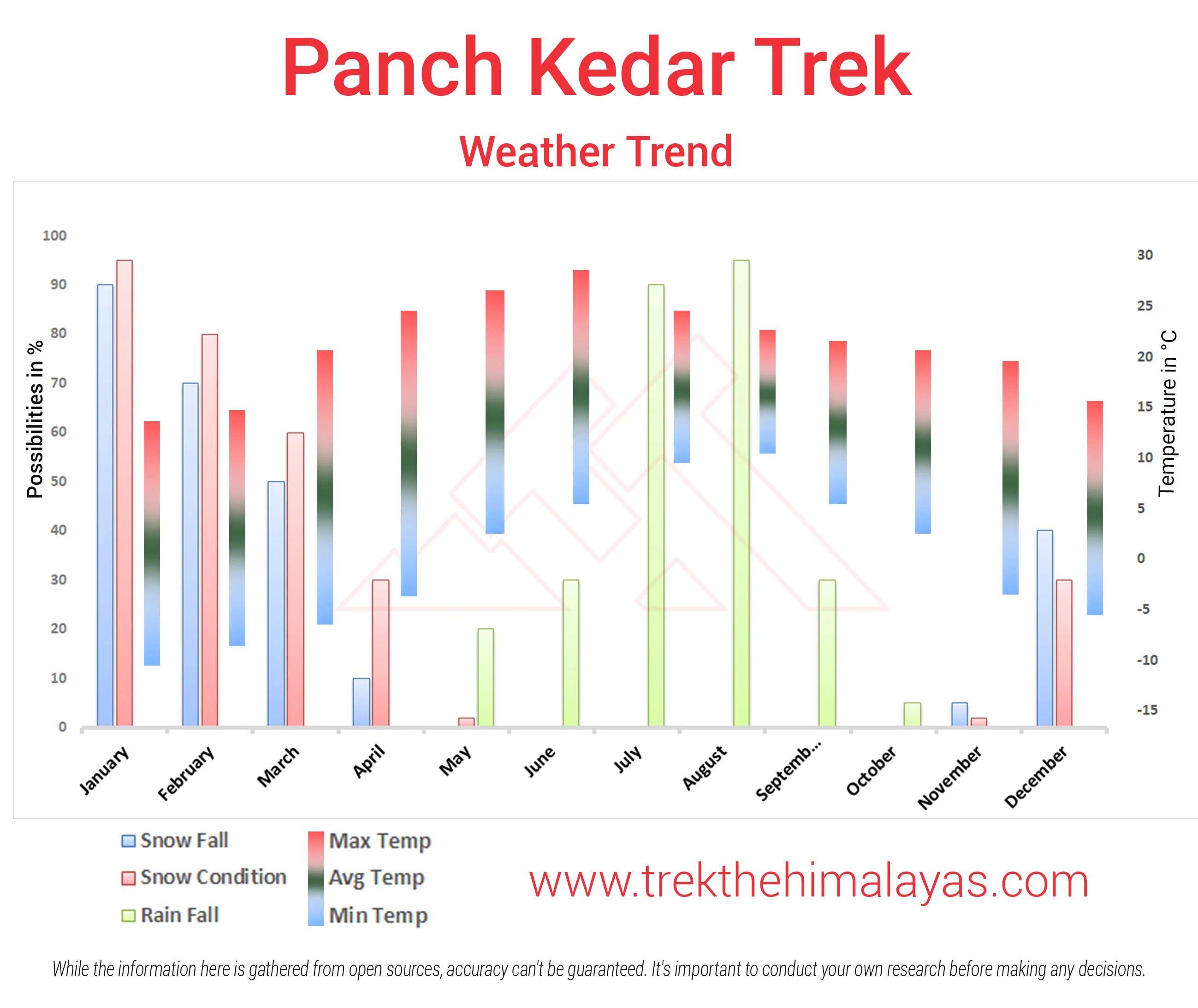
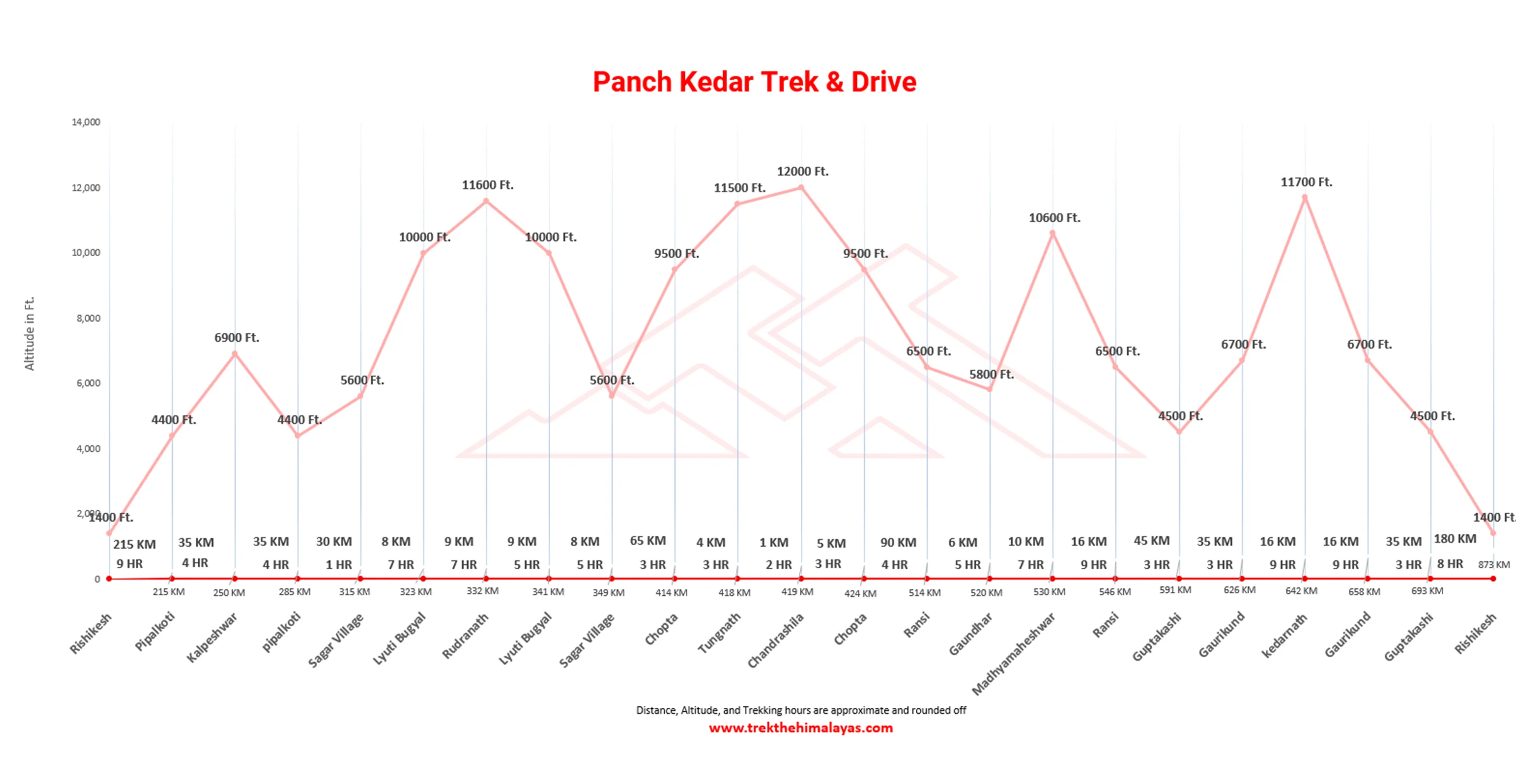
.webp)
- Pulse rate at rest must be in between (60 to 100 beats per minute).
- Blood Pressure Reading must be in between (DIASTOLIC 75 – 85, SYSTOLIC 100 - 130 mm Hg).
- Respiratory rate at rest must be in between (12 to 20 breaths per minute).
- Should not have Liver and kidney issues.
- Should not have Diabetes Mellitus, Bronchial Asthma, Heart problems, Hypertension, etc.
- No pacemaker implant.
- People with Sinus issues, Epilepsy please contact to trek coordinator before booking the trek.
- If your BMI is not normal, Please contact our Trek coordinator before Trek booking.
Medical & Disclaimer Form (Mandatory Documents) Click here to download Medical & Disclaimer Form
- Government Employees can avail the benefit of Special Casual Leave (SCL) when they join us for a trekking expedition. As per the rules of the Pay Commission, Special Casual Leave can be availed for up to 30 days in a calendar year for trekking/mountaineering expeditions through a registered organization. Trek The Himalayas is a registered adventure tour operator by the Indian Mountaineering Foundation (IMF) and the Ministry Of Tourism (MOT).
- Trekkers have to apply for leave at least 20 days before the trek departure date.
- This service is exclusive to Indian government employees and is applicable only for treks within India.
- Do mail at info@trekthehimalayas to apply and mention your booked trek date and trek name.
- Junior trekkers (below 15 years) should have a company of parents/guardians.
- Trekkers between 15 to 18 years can come solo with the disclaimer form signed by parent/guardian.
- Medical & Disclaimer Form (Mandatory Documents) Click here to download Medical & Disclaimer Form
Important Links
- Mandatory Documents to Bring on A Trek Click Here.
- How to pay Add-ons, Submit Medical Forms, and Dietary Preferences Click Here to watch Video
How To Reach
Pick-Up Information
- It is essential for everyone to arrive at Rishikesh (06:00 am)
- Pick-up Location - Tapovan, Landmark -Opposite Shiv Vilas Hotel
- Once you have reached Rishikesh, TTH will manage the rest of your travel arrangements, if you have opted for TTH's pick-up service, you can select this option during the booking process by adding it as an add-on.
Options to Reach Rishikesh
First, you can arrive at Delhi, Dehradun airport or Chandigarh. The journey from these locations to Rishikesh is explained below.
1. Take overnight train/bus to Rishikesh.
2. Take overnight train/bus to Haridwar and drive to Rishikesh (25km | 35 min drive with normal traffic).
3. Take overnight train/bus to Dehradun and drive to Rishikesh (50km | 1hr 20min drive with normal traffic).
( We always recommend going for the govt. Buses over the private ones outside the bus station as based on the experience we have found that there are very high chances of delay involved with private buses. Also, govt. Buses are always more reliable. Whichever bus you choose, just make sure to reach Rishikesh at least by 05:30 am. )
4. Board a flight to Dehradun airport (Jolly Grant Airport) (21 km, 30 min). If you're arriving by air, then come one day in advance.
Drop-Off Information
- The designated drop-off point is Tapovan, Rishikesh.
- Reach in Rishikesh by 6:30 to 7:30 pm.
- Please consider planning your subsequent travel arrangements after 10:00 pm.
Note - In July and August month always have a buffer day in your Itinerary due to the Monsoon.
- It's highly advisable to keep a buffer day in your travel plan. If the buffer day is not used, it can be used to explore Rishikesh.
( If you prefer to travel independently to Base camp and don't want to take TTH's pick-up service, you can either take a government bus or book a private cab from Rishikesh. Your trek coordinator will provide guidance on how to arrange for the bus or cab booking. )
- TTH offers comfortable transportation through Tempo Traveler, Bolero, or equivalent vehicles. If you wish to upgrade your mode of transportation, please contact your trek coordinator for further assistance.
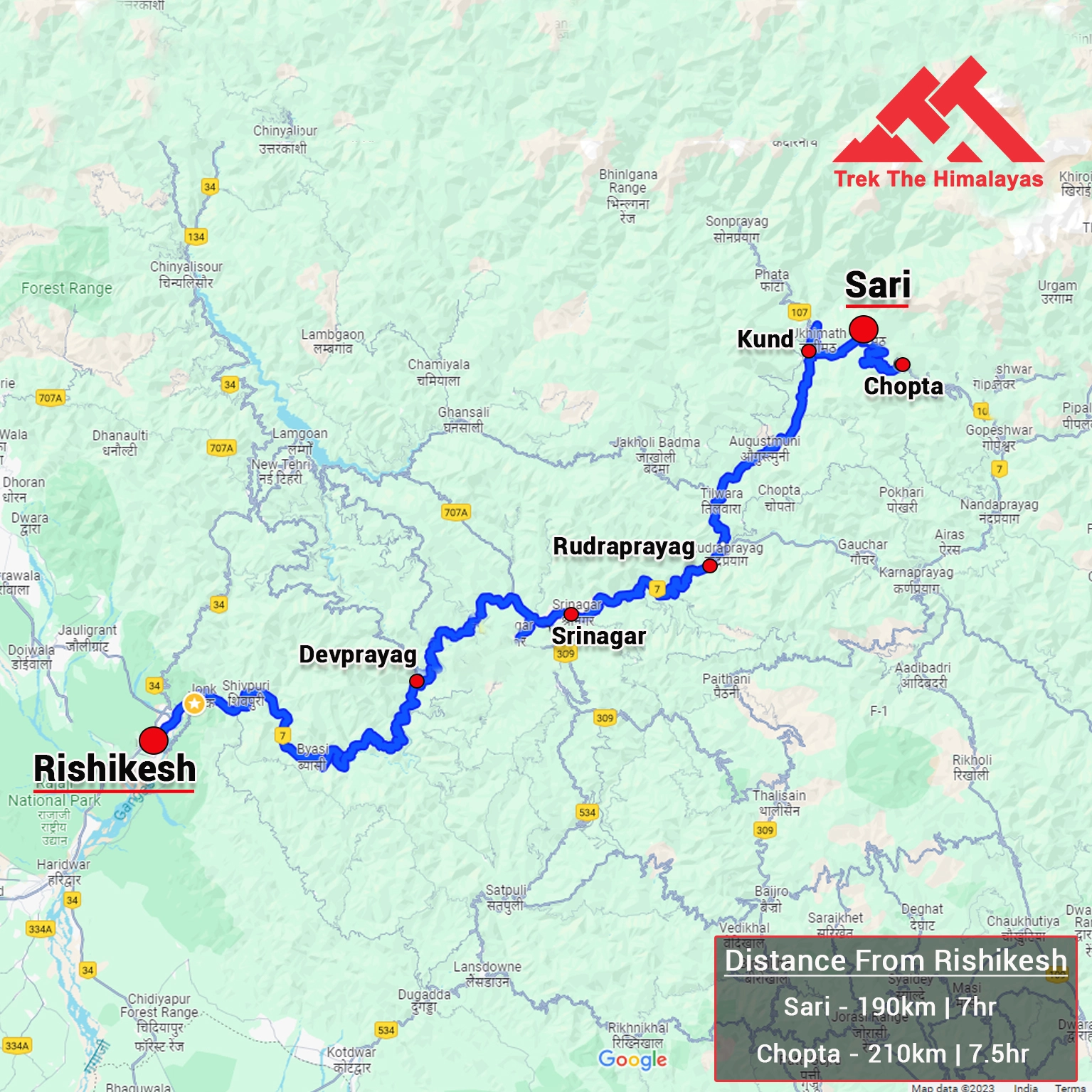
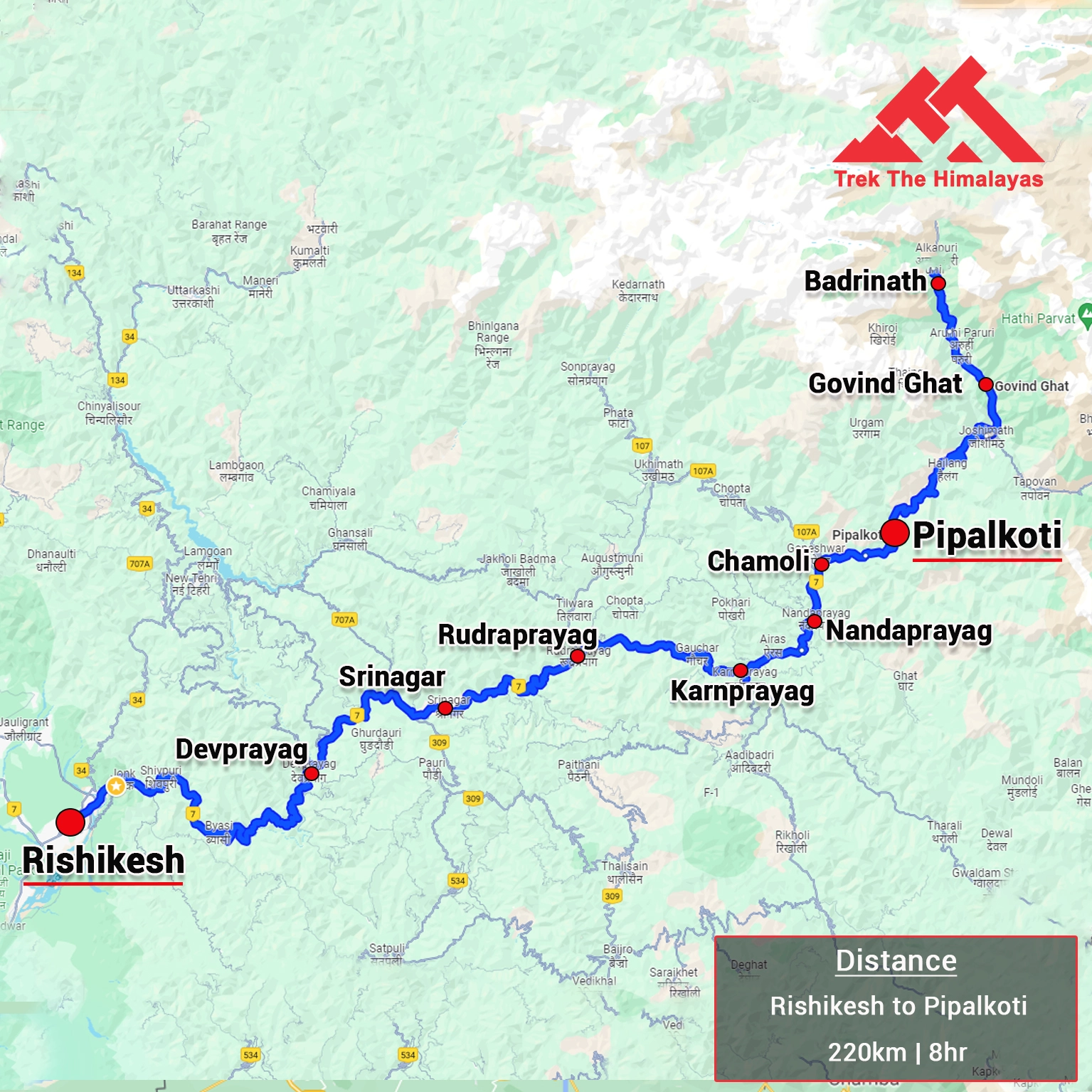
.webp)
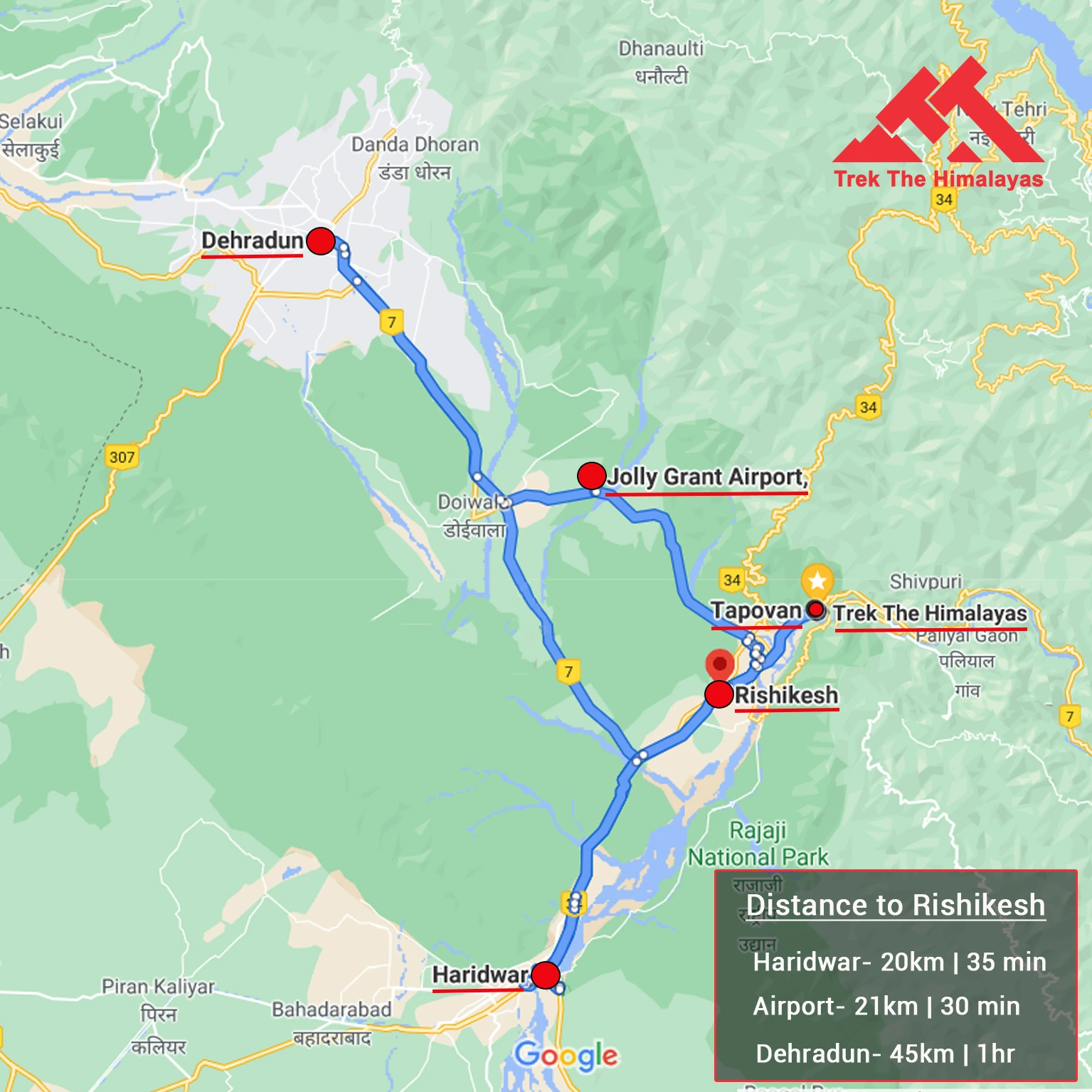
Cost Terms
Inclusion
1. Accommodation (as per the itinerary):
- All the Accommodations are in triple and quad sharing in the Hotel, Guesthouse, camp, and cottage.
2. Meals (Pure veg):
- Day 1 dinner to day 11 dinner
- Breakfast, Lunch, Dinner (as per the hotel/homestay menu)
- 1 cup of tea twice a day (morning/evening)
- Everyday refreshment before starting the trek
3. Support:
- 1 Versatile base camp manager: handles communication and deploys extra manpower in emergencies.
- 1 Mountaineering & First aid qualified professional trek Leader.
- Local experienced guides (Number of guides depending on the group size).
- Enough support staff.
4. First aid:
- Medical kit, Stretcher, Oxygen cylinder, Blood pressure monitor, Oximeter, Stethoscope.
5.Transportation (as per the itinerary):
- Transport from Rishikesh to Rishikesh.
- All road transfers are by AC Vehicle, like Innova / Tempo traveler.
6. Cloakroom facility available for additional luggage
7. All necessary permits and entry fees, up to the amount charged for Indians.
8. Trek Completion Certificate
Exclusion
1. Insurance (Mandatory).
2. Any meals apart from mentioned in the inclusions.
3. Any kind of personal expenses.
4. Mule or porter to carry personal luggage.
5. Emergency evacuation, hospitalization charge or etc.
6. Any extra costs incurred due to extension/change of the itinerary due to natural calamities roadblocks, vehicle breakdown, etc. factors beyond our control.
7. Registration for Kedarnath. Follow the link to register for Kedarnath Click
8. Anything not specifically mentioned under the head Inclusion.
Cancellation Terms
To request a cancellation, please email us at info@trekthehimalayas.com using your registered email ID.
Cancellations prior to 25 days from the start of the Trip
Refund Options
- 5% deduction of trek fee
- 100% cash voucher for any trip till one year
- Transfer your trek (any trek, any date) to your friend
Cancellation between 24 days and 15 days to the start of the Trip
Refund Options
- 30% deduction of trek fee
- 100% cash voucher for same trip till one year
- 85% cash voucher for any trip till one year
- Transfer your trek (same trek, any date) to your friend
Cancellation between 14 days and 10 days to the start of the Trip
Refund Options
- 50% deduction of trek fee
- 80% cash voucher for same trip till one year
- 70% cash voucher for any trip till one year
- Book the same trek, in the same season, with any other batch
- Transfer your trek (same trek, any date) to your friend
Cancellation less than 9 days to the start of the trek.
Refund Options
- No cash refund
- 20% cash voucher for the same trip till one year
- 10% cash voucher for any trip till one year
- Transfer your trek (same trek, same date) to your friend
Cancellation Policy (Emergency Cases):
In case of a death in the immediate family (parents, siblings, spouse, children) or if the trekker is hospitalized (min. 48 hours) or suffers a fracture (leg/arm) within a week before the trek, even if canceled a day before:
90% refund in cash & 10% as a voucher (valid for 1 year, for any India trek)
Valid documents required. We’re here to support you during tough times.
Note:
- Change of trek batch is dependent on the availability of seats in the batch
- In case of transferring a trek to a friend, he/she should satisfy all the mandatory requirements put forward by TTH
- TTH holds the right to change/cancel the policies, without prior notice
Booking and Payments
- The Participant is responsible for verifying the accuracy of all details, including Trip dates and personal documentation, at the time of booking.
- Payments must be made in accordance with the timelines and instructions provided by TTH. Late payments may result in cancellation of booking without refund.
- In the event of a cash refund, only the portion of the payment made in cash shall be eligible for refund in cash. Any booking made using voucher, discounts, promotional codes, or through any non-cash mode of payment shall not be eligible for a cash refund under any circumstances.
- Refunds, if applicable, shall be processed within 15–30 working days of confirmation.
- Voucher Terms
- This is a non-transferable voucher
- The voucher cannot be merged with any other offer of Trek The Himalayas
- The voucher is valid for Trek booked directly with Trek The Himalayas in India
- To avail the voucher please use your register phone number or e-mail id
- All the other Terms of booking a trek with Trek The Himalayas are applicable to the voucher
Itinerary and Modifications
- TTH reserves the right to modify, shorten, or cancel any part of the Trip due to transportation delays, weather, health emergencies, or other unforeseen circumstances including Force Majeure.
Cancellations and Refunds
- No refunds or vouchers, partial or otherwise, shall be provided for voluntary withdrawal, non-utilisation of services, or removal from the Trip.
- If TTH cancels the Trip before arrival at the designated pick-up point due to unforeseen circumstances or Force Majeure, the Participant may choose from:
- An alternate Trip/date.
- A credit voucher valid for one (1) year.
- Transfer to another Trip, with cost differences payable by the Participant.
- If the Trip is abandoned post-arrival at the designated pick-up point, no cash refund or voucher shall be issued. The Trek Again Policy may apply at TTH’s discretion.
- TTH shall not be liable for any associated travel costs such as flights, accommodation, or visa fees.
Force Majeure
- Events beyond its control including but not limited to earthquakes, landslides, strikes, curfews, war, pandemic, government restrictions, heavy rainfall or snowfall, windstorms, road blockages, trail disruption, or withdrawal of permits, TTH shall not be held liable for any cancellation, delay, or service modification caused by Force Majeure.
Trek Essentials
Rent EquipmentPDF Of Trek Essential Download
| Backpack with rain cover | (50 - 60 ltr) with comfortable shoulder straps |
| Day pack with rain cover | 20 - 30 ltr (If off-load opted) |
| Walking stick | Advisable (At least one) |
| Water Bottle / Hydration pack | 2 bottles of one liter each, People who use hydration pack 1 hydration pack and 1 bottle of one liter, Carry at least one thermos flask. |
| Small size tiffin/lunch box | 1 Nos |
| Snacks | Energy bars, dry fruits, electral/ors |
| Personal Medical Kit | Consult your doctor |
| T-Shirt (Synthetic quick dry) | 2 Full & 2 Half sleeves |
| Fleece T-shirt | 2 Nos |
| Wind stopper / Fleece jacket | 1 Nos |
| Windproof Jacket | 1 Nos. |
| Down feather / Hollow jacket | 1 Nos. |
| Thermal inner (Upper and Lower) | 1 Pair |
| Trek Pant (Synthetic quick dry) | 3 Nos. |
| Wind stopper / Fleece Pant | 1 Nos. |
| Waterproof gloves | 1 Pair |
| Fleece / woollen gloves | 1 Pair |
| Poncho / waterproof Jacket and pant | 1 Nos. |
| Sunscreen | 1 Nos. |
| Moisturiser | 1 Nos. |
| Chap-stick / Lip balm | 1 Nos. |
| Toothbrush and toothpaste | 1 Nos. |
| Toilet paper & Wipes | 1 Nos. |
| Soap / hand sanitizers | 1 Nos. |
| Antibacterial powder | 1 Nos. |
| Quick dry towel | 1 Nos. |
| Head torch | 1 Nos. (Avoid Hand torch) |
| Sun Cap | 1 Nos. |
| Woolen cap | 1 Nos. |
| Balaclava | 1 Nos. |
| Buff / Neck-gaiters | 1 Synthetic & 1 Woollen |
| Sunglasses | UV with dark side cover, People who wear spectacles - (A)- Use contact lenses | (B)- Photo chromatic glasses |
| Trekking shoes | 1 Pair (Waterproof, high ankle, good grip) |
| Floaters / flip-flops | 1 Pair |
| Cotton socks | 8 pairs |
| Woollen socks | 3 pairs |
| Gaiters | 1 Pair (TTH provides when required) |
| Micro spikes | 1 Pair (TTH provides when required) |
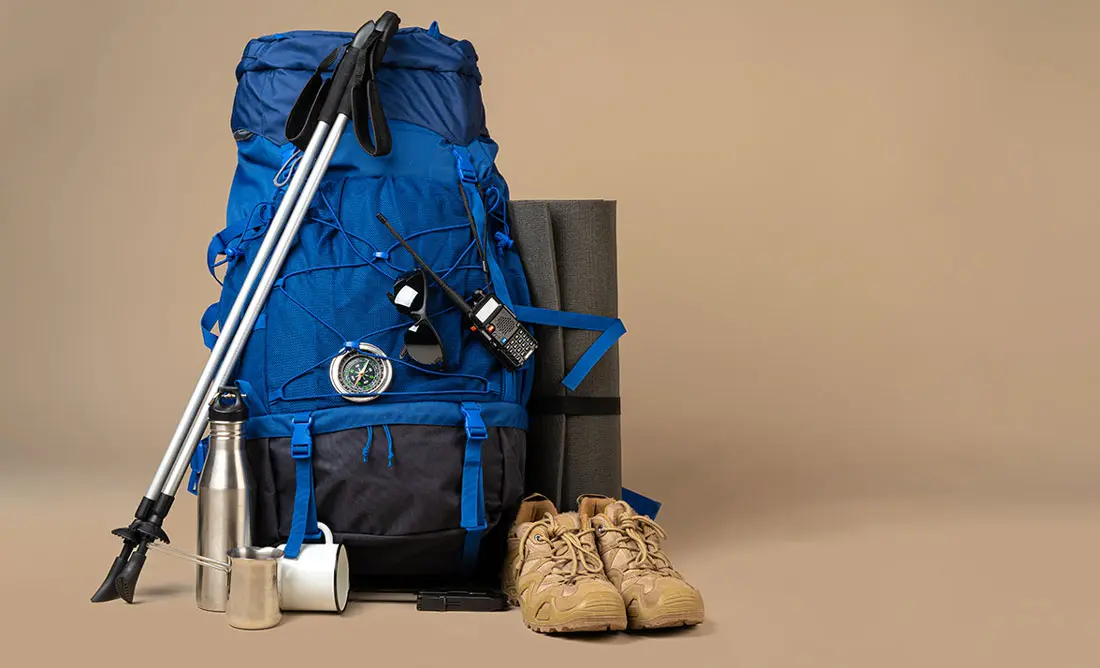
Frequently Asked Questions(FAQ)
To register with TTH, visit our website - www.trekthehimalayas.com and create your account. To create your account you will need to use your email address and fill in all the details, set your unique password and your account is ready to use.
- To book a trek with TTH, you first need to register with us and create an account.
- Choose the trek that you want to do and click on available dates.
- You will land at the login page, fill in the required details.
- Add Participants, choose add-on services click on the Pay now button, choose your preferred payment method, and make the payment. TTH accepts multiple payment options, including credit/debit cards, net banking, and UPI.
- You will receive a confirmation email from TTH with all the necessary details about the trek, including the meeting point, transportation, accommodation, and other important instructions.
- Click Here to watch Video
please send an email to us at info@trekthehimalayas.com or reach out to the numbers provided in the Help and Support section of your Trek Page. We will ensure that your issue is promptly resolved.
To book services such as off-load luggage and transportation, you can find them listed as add-ons. These additional services can be booked at the time of your initial booking. If you miss booking add-ons during the initial reservation, you can log in anytime and easily book 4 days before the departure date add-ons through the platform.
If you have booked the wrong trek or selected the wrong date, don’t worry! You can contact us at +91 9368882322 (Monday to Saturday, 10 AM to 10 PM) or email us at info@trekthehimalayas.com. You can also discuss this with your trek coordinator. Please make sure to inform us at least 10 days before the departure of your trek. Only then can we help you reschedule or arrange another trek for you.
We recommend visiting our "Suggest Me a Trek" page. By filling out the form, our experts will contact you with the best possible trek options based on your preferences and experience level. Alternatively, you can reach out to us via email at info@trekthehimalayas.com or give us a call using the numbers provided on our website for personalized assistance and recommendations.
Family treks differ from regular treks by focusing on ease of difficulty, offering shorter durations for younger participants, Kid-friendly and easily digestible foods, child-friendly activities, maintaining a higher guide ratio for diverse age groups, and implementing additional safety measures for families.
Family Trek with Kids recommendation Only Dayara Bugyal and Chopta Chandrashila Trek.
Minimum age for TTH treks is typically 7 years, though this may vary depending on the specific trek.
Yes, you can take a kids to a high-altitude trek with a parent. Discuss with a trek expert before booking a trek.
- Junior trekkers (below 15 years) should have a company of parents/guardians.
- Trekkers between 15 to 18 years can come solo with the disclaimer form signed by parent/guardian.
- Medical & Disclaimer Form (Mandatory Documents) Click here to download medical and disclaimer form
Physical Fitness: Ensure your child is physically fit. Engage them in regular exercise, outdoor activities, and hikes to build stamina and endurance. Hydration: Emphasize the importance of staying hydrated at high altitudes. Encourage your child to drink water regularly, even if they don't feel thirsty. Proper Nutrition: Provide a well-balanced diet with sufficient carbohydrates for energy and foods rich in iron to prevent altitude sickness. Adequate Sleep: Ensure your child gets enough sleep in the days leading up to the trek. Quality rest is crucial for altitude adaptation. Educate on Altitude Sickness: Teach your child about the symptoms of altitude sickness, such as headache, nausea, and dizziness. Encourage them to communicate any discomfort immediately. Appropriate Clothing and Gear: Dress your child in layers to adjust to changing temperatures. Ensure they have appropriate trekking gear, including sturdy footwear. Positive Mindset: Foster a positive mindset. Encourage your child, and let them know it's okay to take breaks when needed. Medical Check-Up: Schedule a medical check-up before the trek to ensure your child is fit for high-altitude activities. Consult with a healthcare professional about any potential health concerns.
TTH takes special care to provide wholesome and nutritious food for children on treks. Here are some of the foods that are typically served for children:
Breakfast: For breakfast, TTH serves a variety of options like porridge, cornflakes, bread, butter, jam, honey, boiled eggs, omelettes, and pancakes. Children can choose from these options to fuel themselves for the day's trek.
Lunch: For lunch, TTH serves lunch which includes rotis, vegetables, rice, dal, and salad. The rotis are usually made fresh on the trek and are a good source of carbohydrates. The dal and vegetables provide protein and other essential nutrients.
Snacks: TTH provides healthy snacks like fresh fruits, dry fruits, energy bars, cookies, and biscuits to keep the children energized throughout the day.
Dinner: For dinner, TTH serves a hot and wholesome meal which includes soup, rice, dal, vegetables, and a non-vegetarian dish (if requested in advance). Children can also choose from a variety of desserts like custard, jelly, and fruit salad.
Dietary requirements: If a child has any special dietary requirements, TTH can cater to those needs as well. For example, if a child is lactose intolerant or allergic to nuts, the kitchen staff can make arrangements to accommodate those requirements.
Choosing the right trek for a beginner can be a bit overwhelming as there are many factors to consider such as distance, elevation gain, terrain difficulty, weather, and time of year. Here are some tips that can help you choose the right trek for a beginner:
1. Determine fitness level: Assess the fitness level of the beginner to understand their physical capabilities. This will help you select a trek that is challenging but not too difficult.
2. Choose a well-traveled trail: A well-traveled trail will have more amenities such as signposts, water stations, and shelter. It is also safer as there will be other hikers on the trail.
3. Consider the length of the trek: For beginners, it is recommended to start with a shorter trek that can be completed in a day or two. This will help them get acclimatized to trekking and build their confidence.
4. Look for gradual elevation gain: Choose a trek with a gradual elevation gain rather than steep ascents. This will make the trek easier and more enjoyable.
5. Check the weather: Check the weather forecast before selecting a trek. Avoid treks during the monsoon season or winter when the trails can be slippery or dangerous.
6. Research the trail: Read about the trail to get an idea of the terrain, altitude, and difficulty level. This will help you select a trek that is suitable for the beginner.
7. Consult with an expert: If you are unsure about which trek to choose, consult our trek expert Mr. Nitin (+91 70600 59773) between 10 AM to 6 PM (Tuesday - Friday). Mr. Nitin will provide you valuable advice and guidance.
Overall, it is important to choose a trek that is enjoyable, challenging but not too difficult, and suitable for the beginner's fitness level and experience.
It is not recommended for a beginner to choose a difficult Himalayan trek. Trekking in the Himalayas can be physically and mentally challenging, especially if you are not used to the high altitude, steep slopes, and rugged terrain. Choosing a difficult trek without the proper experience, fitness level, and preparation can be dangerous and put you at risk of altitude sickness, injury, and other hazards.
If you are a beginner, it is recommended to start with an easier trek and gradually build up your skills and experience. This will help you understand the challenges of trekking in the Himalayas, and also prepare you physically and mentally for a more difficult trek in the future. It is also important to choose a trek that matches your fitness level, experience, and interest.
There is no specific age limit for a beginner trekker. However, it is important to consider your physical fitness, health condition, and personal interests before embarking on a trek. Trekking in the Himalayas can be physically and mentally demanding, and requires a certain level of physical fitness and endurance.
If you have any pre-existing medical conditions or are above a certain age, it is recommended to consult with a doctor before embarking on a trek. It is also important to listen to your body and take breaks as needed during the trek to prevent exhaustion or injury.
We recommend visiting our "Suggest Me a Trek" page. By filling out the form, our experts will contact you with the best possible trek options based on your preferences and experience level. Alternatively, you can reach out to us via email at info@trekthehimalayas.com or give us a call using the numbers provided on our website for personalized assistance and recommendations.
Yes, you can join the trek. We have fixed departure groups where you can simply book your trek and we will take care of curating a group.
Before you start the trek, it is recommended that you make all the necessary phone calls as during the trek you may or may not receive network coverage, once you come back to the Base Camp, you can reconnect with your family via phone once again. You can share your trek coordinator contact detail with your family members to get the latest updates about your trek batch.
At TTH, we provide wholesome and nutritious meals during the trek. The food is vegetarian and includes a variety of dishes such as rice, dal, vegetables, chapati, paratha, pasta, noodles, and soup. We also offer snacks such as biscuits, and salty, and dry fruits during the trek. Special dietary requirements such as vegan, gluten-free, or Jain food can also be arranged if informed in advance.
If you are allergic to some foods, you need to let us know in advance so that we can make arrangements accordingly.
TTH is a trekking company that prioritizes the safety of all its participants, including women trekkers. We have a comprehensive safety system in place, which includes a dedicated team of experienced and trained trek leaders and support staff who are equipped to handle emergency situations and provide first aid.
TTH also takes specific measures to ensure the safety and comfort of women trekkers. They have a separate tent accommodation for women trekkers, female trek leaders, and support staff. They also provide separate toilet facilities for women and encourage a safe and respectful environment for all trekkers.
Moreover, TTH has a strict policy against any kind of harassment and has a zero-tolerance policy towards such incidents. They have a designated Internal Complaints Committee (ICC) to investigate and address any complaints related to harassment or misconduct. Overall, TTH has a good reputation for safety and responsible trekking practices, and women can feel comfortable and safe while trekking with them.
In case you are the only women in the group, we provide a single sleeping arrangement. Also, during the trek, the trek leader will always remain by your side to provide optimum safety and reassurance.
You can reach out to the trek coordinator to inquire about the number of female trekkers and their respective states who have booked the trek. Please note that the trek coordinator cannot disclose personal details of any trekker. Once you've confirmed your booking, a WhatsApp Group will be created for all the trekkers in your batch. This allows you to connect with fellow trekkers before the trek begins.
While many of our treks are led by female trek leaders, however, it is not possible to know which trek leader is assigned to which group. But nonetheless, whether the trek leader is male or female you can be completely assured of your safety and security with us.
Yes, it is possible to trek with periods. However, it is important to take some extra precautions and preparations to ensure a comfortable and safe trekking experience. Here are some tips that can help you trek during your period:
1. Use menstrual hygiene products that you are comfortable with, such as tampons, pads, or menstrual cups. It is recommended to carry enough supplies for the entire duration of the trek.
2. Pack wet wipes, hand sanitizer, and plastic bags to dispose of used hygiene products.
3. Wear comfortable and breathable clothing that allows for easy movement and reduces friction. Avoid wearing tight or restrictive clothing that can cause discomfort.
4. Carry pain relief medication, such as ibuprofen or acetaminophen, in case of menstrual cramps.
5. Stay hydrated and maintain a balanced diet to support your energy levels and overall health.
6. Take breaks as needed and listen to your body. If you feel uncomfortable or experience any unusual symptoms, seek medical attention immediately. It is also recommended to consult with a doctor before going on a trek during your period, especially if you have a pre-existing medical condition or are taking medication.
By taking necessary precautions and being prepared, you can have a safe and comfortable trekking experience even during your period. We provide proper disposal facilities for sanitary pad disposal during the trek.
We offer three person tents with twin-sharing for optimum comfort. A woman trekker will share a tent with another woman trekker and if you are the only woman in the group, you will be given a single accommodation for your comfort and privacy.
Yes, we do provide gears on rent. You can book it using you TTH account directly.
Mountaineering qualified Experienced and first aid certified Trek Leader, First Aid Certify local guide, Cook, helpers and supporting staff.
People suffering from Bronchitis, Asthma, High blood pressure, Epilepsy (got faints), TB , Heart problem or on higher BMI side are strictly not allowed to go on any Himalayan trek. Apart from this if you had any medical history, please let us know.
No. Alcohol and smoking isn’t allowed while on trek. It is totally misconception that it will keep you warm. Your body need to acclimatize properly and for that eat properly and drink enough water; these things will keep you warm.
Toilet tents provide a convenient solution for answering nature's call in the great outdoors. Dry toilets, in particular, offer a highly sanitary approach. By digging a pit and utilizing mud and a shovel, you can easily cover up your waste. This method ensures cleanliness and hygiene while camping or exploring in the forest.
Remember to pack essential toiletries to complete your outdoor bathroom kit and maintain proper personal hygiene during your adventures. With these practices in place, you can enjoy nature while also respecting it.
Layer Up From Head To Toe
Eat Full Meals, never sleep empty stomach
You can keep warmee (if you’re more susceptible to cold).
Use sleeping bag in right way and don’t leave free space in sleeping bag.
For upper body
– Thermal layer
– T-shirt (full-sleeves)
– Fleece T-shirt (for extreme colds)
– Fleece layer
– Thick Jacket/Down Jacket
– Waterproof or Windproof layer (outermost layer, when it is snowing or raining)
- For Lower Body
– Thermal layer
– Hiking pants (normal) or Winter hiking pants
Based on how warm you feel you can skip any of the above layers. Your outer later should be windproof since it is windy at high altitude.
The idea behind layering is that the more insulation you have the less cold you feel, and instead of wearing a very thick jacket if you wear multiple layers, your body will be better insulated against the cold.
Yes, we provide micro spikes and gaiters, if required.
Mandatory documents: 2 xerox of ID having address (addhar card/driving license), 2 Passport size photographs, hard copy Medical form signed & sealed by doctor, disclaimer form sign by trekker and high altitude insurance.
No. We don’t but we can suggest you good hotel/Stay nearby pick up location.
Yes, trekker must carry 2 water bottles 1 litre each so they can refill it at campsite for drinking and keep themselves hydrate.
You should buy shoes which has these three features –Good grip, Ankle Support and additional water resistant layers. Generally, we advise Quechua Trek 100, MH 500 and MH 100.
No one is forced to go on. There is always enough staff to split the party according to need and regroup later at the camp. Most people have no trouble reaching the highest campsite. If some members decide not to climb the final distance they can wait for the climbers to come back down the same way or take a lateral path to the descent route.
Trek The Himalayas is the safest and most trusted trekking organization in India. Our deep expertise and commitment ensure that each trekker can fully immerse in the Himalayan beauty while experiencing a well-organized and memorable journey. We are proud to be recognized among the best trekking companies in India and have been awarded the PHD Samman Award two years consecutively for Best Adventure Tour Operator. Our founders, themselves are proficient mountaineers and belong to the hilly states of India. At TTH we follow all the safety protocols. Our Trek Leaders are expertly trained in First Aid and Acute Mountain Sickness (AMS) management. The extensive experience is a key factor in establishing us as the best trekking company in India.
Explore the best trekking companies in India and see what sets them apart.Yes, Trek The Himalayas (TTH) provides customized trekking packages, and premium trek packages, apart from fixed departures tailored to your preferences and needs. We understand that each trekker has unique interests, timeframes, and fitness levels, so we are happy to design a customized trek package that aligns with your goals. If you are seeking a specific experience, such as camping under the stars, a photography-focused trek, or an itinerary that includes cultural and heritage sites, our team can help create the ideal trekking package for you.
With a customized trek, you have the flexibility to choose aspects like trek difficulty, duration, group size, and even special add-ons like guided tours of nearby villages or extended camping nights at scenic locations.
Our customization options are ideal for families, groups, corporate teams, and solo adventurers looking for a tailored journey through the Himalayas.
Yes, you need special permits for Trekking in India, especially in protected or restricted areas. In states like Uttarakhand, Himachal Pradesh, and Ladakh, trekkers may need to obtain permits from local authorities or forest departments before starting their journey. For international trekkers, special permits like the Inner Line Permit (ILP) are required for regions such as Ladakh and Arunachal Pradesh. To make the process easier, Trek The Himalayas assist adventurers in obtaining all the necessary paperwork and permits, ensuring a hassle-free trekking experience.
Trek The Himalayas is committed to promoting Sustainable Tourism and Eco-Friendly Tourism by following responsible trekking practices and encouraging our trekkers to do the same.
We have introduced impactful initiatives like Heal Himalaya and Leave No Trace. Through these programs, we regularly organize cleaning drives along trekking routes and surrounding areas to keep the trails free from litter. Our team carries trash bags during every trek, ensuring that all waste collected from the slopes is brought back to the base and disposed of properly. We also take active steps to reduce plastic waste by completely avoiding the use of single-use plastics and encouraging our trekkers to do the same. Small changes like carrying reusable bottles and eco-friendly alternatives can make a big difference in protecting the environment.
By choosing to trek with us, you become a part of this movement toward responsible and sustainable trekking.
Yes, Trek the Himalayas provides trekking tours to well-known pilgrimage sites, including Kailash Mansarovar Yatra, Adi Kailash Yatra, Char Dham Yatra, and Panch Kedar.
Trekking in India offers something for everyone, from easy trails for beginners to tough and challenging routes. If you're planning to go for high-altitude or difficult treks like Kang Yatse or Pin Parvati, it's better to have some prior trekking experience.
However, if you're new to trekking, there are many beautiful and beginner-friendly options to start with, like Dayara Bugyal, Ali Bedni, Chandrakhani Pass, Sandakphu, Surya Top, and many others. Your preparation depends on the trek you choose. Easier treks need basic fitness, while tougher ones require more training and experience.
India offers a wide range of beautiful treks, and the best one really depends on your fitness level, experience, and what kind of views or adventure you’re looking for. Here are some of the most popular and well-loved treks:
Sandakphu Trek, Sikkim/West Bengal – Famous for views of four of the five highest peaks in the world.
Dayara Bugyal Trek, Uttarakhand – A perfect choice for beginners with scenic meadows and easy trails.
Ali Bedni Bugyal Trek, Uttarakhand – Known for its lush meadows and close views of Mount Trishul and Nanda Ghunti.
Pin Bhaba Pass Trek, Himachal Pradesh – A stunning crossover trek with changing landscapes.
Kashmir Great Lakes Trek, Jammu and Kashmir – One of the most beautiful treks in India, with alpine lakes and valleys.
Ranthankharak Trek, Uttarakhand – A less-crowded trail offering peace and beautiful mountain views.
Valley of Flowers Trek, Uttarakhand – A UNESCO World Heritage Site, famous for its vibrant blooms during monsoon.
Choose the one that matches your fitness and interest, and you’re in for an unforgettable experience.
Deciding which Indian state has the "best" trekking is tough, as it really depends on what you're looking for. However, Himachal Pradesh and Uttarakhand consistently stand out as top contenders, both offering incredible variety and stunning Himalayan scenery.
Himachal Pradesh is a trekker's paradise, boasting the Dhauladhar, Pir Panjal, Shivalik, and Zanskar ranges. Uttarakhand, often called the "Land of Gods," also has an abundance of beautiful trails. Its Garhwal and Kumaon regions feature iconic treks through lush alpine meadows that turn into snowy landscapes in winter.
Apart from Himachal and Uttarakhand Sikkim (with views of Kanchenjunga) and parts of Jammu & Kashmir (like the Kashmir Great Lakes trek) also offer unique and exceptional experiences. Ultimately, the "best" state depends on your preference for lush valleys, spiritual paths, or remote mountain adventures.
For beginners, one of the best trekking options is the Nag Tibba trek in Uttarakhand. It’s an easy to moderate trek, perfect for first-timers. The trail offers beautiful mountain views, takes just a couple of days, and gives a good idea of what trekking in the Himalayas feels like.
Other beginner-friendly treks that are slightly longer but still manageable include Kedarkantha, Bhrigu Lake, Kuari Pass, and Dayara Bugyal. These treks are not very tough and give you more time in the mountains, with amazing scenery and a great learning experience.
To start trekking in India, follow these simple steps:
1. Choose an easy trek: Pick a beginner-friendly trek that matches your fitness level. Go for shorter and well-marked routes that don’t have very steep climbs or high altitudes. Treks like Chopta–Chandrashila, Nag Tibba, or Dayara Bugyal are great options to begin with.
2. Work on your fitness: Start getting fit a few weeks before your trek. Focus on building stamina by walking daily, especially on stairs or slopes. Jogging, cycling, or light exercises to strengthen your legs and core will also help you enjoy the trek better.
3. Get the right gear: Invest in a few good essentials, comfortable trekking shoes, a light but strong backpack, and layered clothing that works for changing mountain weather. Don’t forget basics like a water bottle, headlamp, and trekking poles for better comfort and safety on the trail.
With the right planning and preparation, trekking can be a fun and unforgettable experience!
The “most beautiful trek in India” can vary from person to person, but some treks are widely known for their scenic views. Valley of Flowers, Hampta Pass, Pin Bhaba Pass, and Kashmir Great Lakes are often considered the most scenic treks in the country.
These treks have some of the best landscapes, snow-covered mountains, lush green meadows, crystal-clear rivers, and in some places, vibrant wildflowers spread across the valley. The mix of colors, natural beauty, and peaceful surroundings make these treks a visual treat for every nature lover.
The Panch Kedar trek and drive takes 12 Days to complete. This duration covers visits to all five sacred Kedars, Kedarnath, Madhyamaheshwar, Tungnath, Rudranath, and Kalpeshwar, along with trekking through beautiful Himalayan villages, dense forests, and high-altitude meadows.
During the Panch Kedar Yatra, you would have to cover a total trekking distance of 107 kilometers in a span of 12 days. This 12-day journey isn’t just a physical challenge but also a soulful experience, as you walk along paths tread by sages and pilgrims for centuries.
During the Panch Kedar trek, the first Kedar visited is the Kalpeshwar.
The Panch Kedar trek Package includes all essential facilities to ensure a smooth and comfortable experience including the drives. A comfortable accommodation and all meals are provided, including tea, soup, and snacks. The package also includes a professional trek leader, experienced local guides, a skilled high-altitude chef, and sufficient support staff. High-quality trek equipment like tents, sleeping bags, and essential safety gear is provided.
Medical assistance is available with a first aid kit, oxygen cylinder, and other necessary equipment. Transportation for the entire trek route, including pick-up and drop-off, is included. Additionally, mules or porters carry central luggage, a cloakroom facility is available for extra baggage, and all necessary permits and entry fees are covered. A trek completion certificate is also provided.
The Panch Kedar Yatra is considered to be a moderate to difficult trek, with steep ascents and descents, rough terrain, and unpredictable weather. It requires a good level of physical fitness and experience in trekking.
In the Panch Kedar trek, the easiest is Kalpeshwar, as it requires no long trekking distance and is easily accessible by road. The toughest is the Rudranath trek because of its challenging terrain, followed by Kedarnath, known for its long trekking distance and higher altitude.
During the Panch Kedar Yatra, you’ll get to witness stunning views of the majestic Himalayas. Some of the prominent peaks visible along the trek include Kedarnath Main, Kedarnath Dome, Chaukhamba, Neelkanth, Nanda Devi, Nanda Ghunti, Kamet, Dronagiri, and Mount Trishul. The beautiful snow-covered peaks and peaceful mountain landscapes make the entire journey even more memorable for every trekker.
Horses are available for the Panch Kedar Yatra during the peak season. But if you’re visiting in the off-season, finding them can be a little tough.
The Panch Kedar Trek and Drive is a trekking route in the Indian state of Uttarakhand that covers the five holy shrines of Lord Shiva known as Panch Kedar. It is a moderately challenging trek that covers a distance of approximately 107 kilometres and includes driving and trekking through remote and rugged terrain.
Accommodation during the Panch Kedar Trek and Drive is primarily in tents, guesthouses or homestays depending upon the location.
The best time to do the Panch Kedar Yatra is during the months of May, June, September, and October. These months offer pleasant weather, clear mountain views, and ideal trekking conditions. Most importantly, all five temples remain open for pilgrims and trekkers during this time.
It’s not recommended to visit during the monsoon months, as the region experiences heavy rainfall, slippery trails, and frequent landslides, making the trek risky. In winter, from November to April, the area receives heavy snowfall, and the temples remain closed as the routes become completely inaccessible.
The five shrines of Panch Kedar are Kedarnath, Tungnath, Rudranath, Madhyamaheshwar, and Kalpeshwar. These shrines are considered to be holy by Hindus and are believed to be the places where Lord Shiva appeared in the form of natural elements such as hair, arms, navel, face, and matted hair.
The Panch Kedar region is home to a variety of wildlife, including Himalayan Tahr, musk deer, Red Fox and various species of birds. While sightings are not guaranteed, trekkers should keep an eye out for these animals and respect their habitats.
The Panch Kedar Trek and Drive starts and ends in Rishikesh. You can easily reach Rishikesh by bus or train from major cities. Another option is to take an overnight bus, train, or flight to Dehradun, and then drive to Rishikesh. The distance from Dehradun to Rishikesh is about 1.5 hours by road. Once you reach Rishikesh, the trek services and road journey towards the Panch Kedar temples begin from there.
Yes, permits are required for the Panch Kedar Yatra, as it passes through protected areas. These permits help regulate footfall and ensure the conservation of the region’s biodiversity. However, you don’t have to worry about arranging them yourself. If you are trekking with an experienced organization like TTH (Trek The Himalayas), all necessary permits, forest permissions, and related fees are taken care of and included in your trek package. This allows you to enjoy the trek without the stress of handling logistics.
The Panch Kedar with Trek The Himalayas are visited in the following order-
Kalpeshwar
Rudranath
Tunganath
Madhyamaheshwar
Kedarnath
Yes, first timers can do the Panch Kedar trek. However, basic fitness is mandatory. If you are a first timer attempting the Panch Kedar trek, it is highly recommended to prepare in advance. Engage in regular walking, cardio exercises, and light strength training at least a month before the trek. This will help improve stamina and reduce the risk of fatigue or injury during the trek.
The Panch Kedar trek, covering Kedarnath, Tungnath, Rudranath, Madhyamaheshwar, and Kalpeshwar, involves moderate to slightly challenging trails, with varying terrains and altitudes. Being mentally prepared for long hours of walking, sometimes on uneven and steep paths, is essential.
Yes, permits are required for the Panch Kedar Yatra, as it passes through protected areas. These permits help regulate footfall and ensure the conservation of the region’s biodiversity. However, you don’t have to worry about arranging them yourself. If you are trekking with an experienced organization like TTH (Trek The Himalayas), all necessary permits, forest permissions, and related fees are taken care of and included in your trek package. This allows you to enjoy the trek without the stress of handling logistics.
The opening dates for Panch kedar temples are:
Kedarnath: May 2, 2025.
Tungnath: May 2, 2025.
Madhyamaheshwar: 21, 2025.
Rudranath: 18, 2025.
Kalpeshwar: Remains open throughout the year.
.webp)
.webp)
.webp)
.webp)
.webp)
.webp)
.webp)
.webp)


